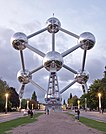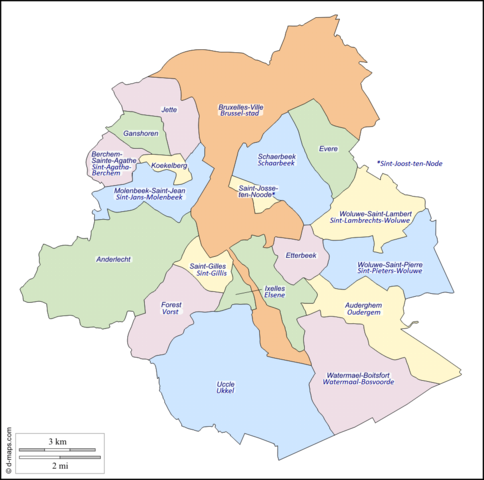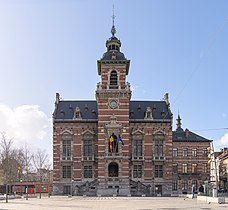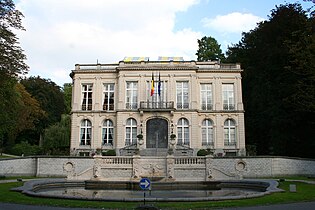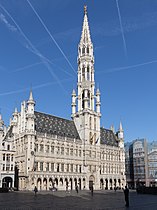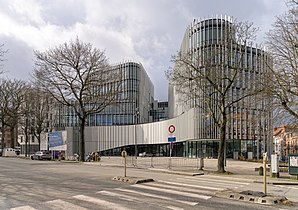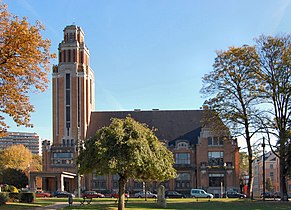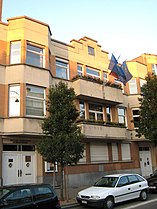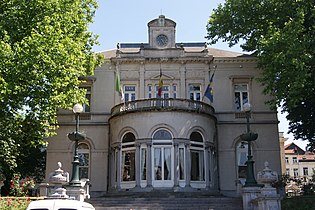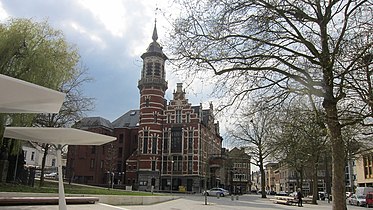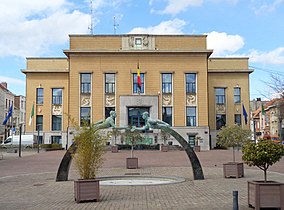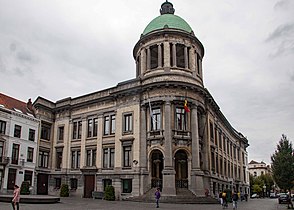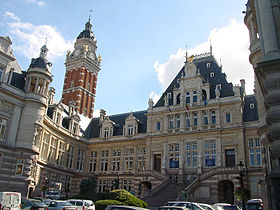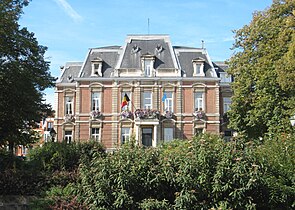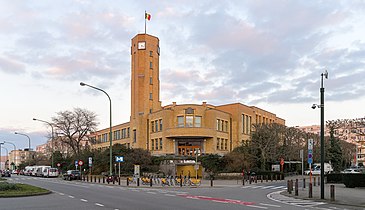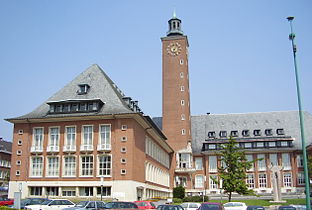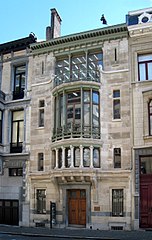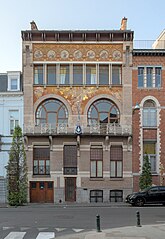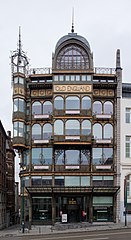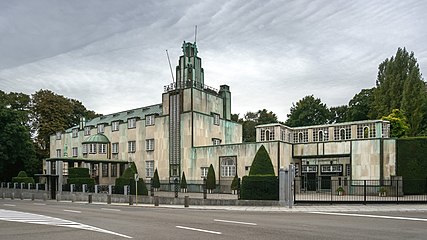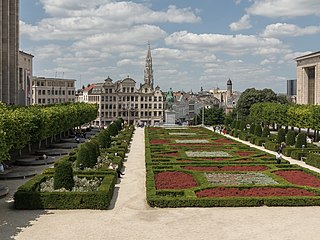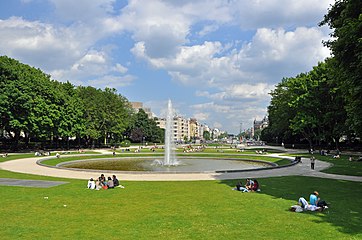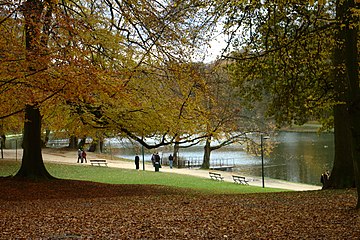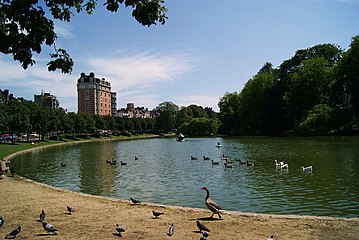Brussels
Brussels(French:Bruxelles,pronounced[bʁysɛl]or[bʁyksɛl];Dutch:Brussel[ˈbrʏsəl]), officially theBrussels-Capital Region[12][13](French:Région de Bruxelles-Capitale;[a]Dutch:Brussels Hoofdstedelijk Gewest),[b]is aregionofBelgiumcomprising19 municipalities,including theCity of Brussels,which is the capital of Belgium.[14]The Brussels-Capital Region is located in the central portion of the country and is a part of both theFrench Community of Belgium[15]and theFlemish Community,[16]but is separate from theFlemish Region(within which it forms anenclave) and theWalloon Region,located less than 4 kilometres (2.5 mi) to the south.[17][18]Historically Dutch-speaking, Brussels saw alanguage shift to Frenchfrom the late 19th century.[19]Nowadays, the Brussels-Capital Region is officially bilingual in French and Dutch,[20][21]although French is the majority language andlingua franca.[22]Brussels is also increasingly becoming multilingual. English is spoken widely and many migrants andexpatriatesspeak other languages as well.[22][23]
Brussels grew from a small rural settlement on the riverSenneto become an important city-region in Europe. Since the end of theSecond World War,it has been a major centre forinternational politicsand home to numerous international organisations, politicians,diplomatsandcivil servants.[24]Brussels is thede factocapital of theEuropean Union,as it hosts a number of principalEU institutions,including itsadministrative-legislative,executive-political,andlegislativebranches (though the judicial branch is located inLuxembourg,and the European Parliament meets for a minority of the year inStrasbourg).[1][25][c]Because of this, its name is sometimes usedmetonymicallyto describe the EU and its institutions.[26][27]The secretariat of theBeneluxand theheadquartersofNATOare also located in Brussels.[28][29]
Brussels is the most densely populated region in Belgium, and although it has the highestGDP per capita,[30]it has the lowest available income per household.[31]The Brussels Region covers 162 km2(63 sq mi) and has a population of over 1.2 million.[32]Its five times largermetropolitan areacomprises over 2.5 million people, which makes it thelargest in Belgium.[33][34][35]It is also part of a largeconurbationextending towards the cities ofGhent,Antwerp,andLeuven,known as theFlemish Diamond,as well as the province ofWalloon Brabant,in total home to over 5 million people.[36]As Belgium's economic capital and a top financial centre in Western Europe withEuronext Brussels,Brussels is classified as anAlphaglobal city.[37]It is also a national and international hub for rail, road and air traffic,[38]and is sometimes considered, together with Belgium, as Europe's geographic, economic and cultural crossroads.[39][40][41]TheBrussels Metrois the onlyrapid transitsystem in Belgium. In addition, both itsairportandrailway stationsare the largest and busiest in the country.[42][43]
Brussels is known for its cuisine and gastronomic offer (including its localwaffle,itschocolate,itsFrench friesand its numerous types ofbeers),[44]as well as its historical and architectural landmarks; some of them are registered asUNESCOWorld Heritage Sites.[45]Principal attractions include its historicGrand-Place/Grote Markt(main square),Manneken Pis,theAtomium,and cultural institutions such asLa Monnaie/De Muntand theMuseums of Art and History.Due to its long tradition ofBelgian comics,Brussels is also hailed as a capital of thecomic strip.[3][46]
Toponymy
[edit]Etymology
[edit]The most common theory of the origin of the nameBrusselsis that it derives from theOld DutchBruocsella,BroekzeleorBroeksel,meaning'marsh'(bruoc/broek) and'home, settlement'(sella/zele/sel) or'settlement in the marsh'.[47][48]Saint Vindicianus,the Bishop ofCambrai,made the first recorded reference to the placeBrosellain 695,[49]when it was still ahamlet.The names of all the municipalities in the Brussels-Capital Region are also ofDutchorigin, except forEvere,which is possiblyCelticorOld Frankish.[50]
Pronunciation
[edit]InFrench,Bruxellesis pronounced[bʁysɛl](thexis pronounced/s/,like inEnglish,and the finalsis silent) and in Dutch,Brusselis pronounced[ˈbrʏsəl].Inhabitants of Brussels are known in French asBruxellois(pronounced[bʁysɛlwa]) and in Dutch asBrusselaars(pronounced[ˈbrʏsəlaːrs]). In theBrabantian dialectof Brussels (known asBrusselian,and also sometimes referred to as Marols or Marollien),[51]they are calledBrusseleersorBrusseleirs.[52]
Originally, the writtenxnoted the group/ks/.In theBelgian Frenchpronunciation as well as in Dutch, thekeventually disappeared andzbecames,as reflected in the currentDutch spelling,whereas in the more conservativeFrench form,the spelling remained.[53]The pronunciation/ks/in French only dates from the 18th century, but this modification did not affect the traditional Brussels usage. InFrance,the pronunciations[bʁyksɛl]and[bʁyksɛlwa](forbruxellois) are often heard, but are rather rare in Belgium.[54]
History
[edit]Early history
[edit]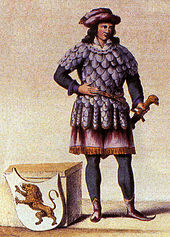
The history of Brussels is closely linked to that ofWestern Europe.Traces of human settlement go back to theStone Age,with vestiges and place-names related to the civilisation ofmegaliths,dolmensandstanding stones(Plattesteen near theGrand-Place/Grote MarktandTomberginWoluwe-Saint-Lambert,for example). Duringlate antiquity,the region was home toRomanoccupation, as attested by archaeological evidence discovered on the current site ofTour & Taxis,north-west of thePentagon(Brussels' city centre).[55][56]Following the decline of theWestern Roman Empire,it was incorporated into theFrankish Empire.
According to local legend, the origin of the settlement which was to become Brussels lies inSaint Gaugericus' construction of a chapel onan islandin the riverSennearound 580.[57]The official founding of Brussels is usually said to be around 979, whenDuke Charles of Lower Lorrainetransferred therelicsof themartyrSaint GudulafromMoorsel(located in today's province ofEast Flanders) to Saint Gaugericus' chapel. WhenHoly Roman EmperorOtto IIappointed the same Charles to become Duke ofLower Lotharingiain 977,[58]Charles ordered the construction of the city's first permanent fortification, doing so on that same island.
Middle Ages
[edit]Lambert I of Leuven,Count of Leuven,gained the County of Brussels around 1000, by marrying Charles' daughter. Because of its location on the banks of the Senne, on animportant trade routebetween theFlemishcities ofBrugesandGhent,andColognein theKingdom of Germany,Brussels became a commercial centre specialised in the textile trade. The town grew quite rapidly and extended towards the upper town (Treurenberg,CoudenbergandSablon/Zavelareas), where there was a smaller risk of floods. As it grew to a population of around 30,000, the surrounding marshes were drained to allow for further expansion. In 1183, the Counts of Leuven becameDukes of Brabant.Brabant, unlike the county of Flanders, was not fief of the king of France but was incorporated into theHoly Roman Empire.
In the early 13th century, thefirst walls of Brusselswere built,[59]and after this, the city grew significantly. Around this time, work began on what is now theCathedral of St. Michael and St. Gudula(1225), replacing an olderRomanesquechurch.[60]To let the city expand,a second set of wallswas erected between 1356 and 1383. Traces of these walls can still be seen, although theSmall Ring,a series of boulevards bounding the historical city centre, follows their former course.
Early modern
[edit]
In the 14th century, the marriage between heiressMargaret III of FlandersandPhilip the Bold,Duke of Burgundy,produced a new Duke of Brabant of theHouse of Valois,namelyAntoine,their son.[61]In 1477, the Burgundian dukeCharles the Boldperished in theBattle of Nancy.[62]Through the marriage of his daughterMary of Burgundy(who was born in Brussels) to Holy Roman EmperorMaximilian I,theLow Countriesfell underHabsburgsovereignty.[63]Brabant was integrated into this composite state, and Brussels flourished as the Princely Capital of the prosperousBurgundian Netherlands,also known as theSeventeen Provinces.After the death of Mary in 1482, her sonPhilip the Handsomesucceeded as Duke of Burgundy and Brabant.
Philip died in 1506, and he was succeeded by his sonCharles Vwho then also becameKing of Spain(crowned in theCathedral of St. Michael and St. Gudula) and even Holy Roman Emperor at the death of his grandfather Maximilian I in 1519. Charles was now the ruler of aHabsburg Empire"on which the sun never sets" with Brussels serving as one of his main capitals.[2][64]It was in theCoudenberg Palacethat Charles V was declared of age in 1515, and it was there in 1555 that he abdicated all of his possessions and passed theHabsburg NetherlandstoKing Philip II of Spain.[65]This palace, famous all over Europe, had greatly expanded since it had first become the seat of the Dukes of Brabant, but it was destroyed by fire in 1731.[66][67]
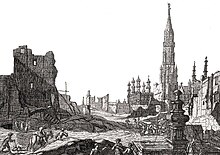
In the 16th and 17th centuries, Brussels was a centre for thelaceindustry. In addition,Brussels tapestryhung on the walls of castles throughout Europe.[68][69]In 1695, during theNine Years' War,King Louis XIV of Francesent troops tobombard Brussels with artillery.Together with the resulting fire, it was the most destructive event in the entire history of Brussels. The Grand-Place was destroyed, along with 4,000 buildings—a third of all the buildings in the city. The reconstruction ofthe city centre,effected during subsequent years, profoundly changed its appearance and left numerous traces still visible today.[70]
During theWar of the Spanish Successionin 1708, Brussels again sustained aFrench attack,which it repelled. Following theTreaty of Utrechtin 1713, Spanish sovereignty over the Southern Netherlands was transferred to the Austrian branch of the House of Habsburg. This event started the era of theAustrian Netherlands.Brusselswas capturedby France in 1746, during theWar of the Austrian Succession,[71]but was handed back to Austria three years later. It remained with Austria until 1795, when the Southern Netherlands were captured and annexed by France, and the city became thechef-lieuof thedepartment of the Dyle.[72][73]The French rule ended in 1815, with the defeat ofNapoleonon thebattlefield of Waterloo,located south of today's Brussels-Capital Region.[74]With theCongress of Vienna,the Southern Netherlands joined theUnited Kingdom of the Netherlands,underKing William I of Orange.The former Dyle department became the province ofSouth Brabant,with Brussels as its capital.
Late modern
[edit]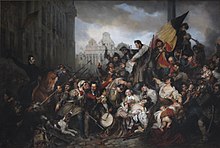
In 1830, theBelgian Revolutionbegan in Brussels, after a performance ofAuber'soperaLa Muette de Porticiat theRoyal Theatre of La Monnaie.[75]The city became the capital and seat of government of the new nation. South Brabant was renamed simplyBrabant,with Brussels as its administrative centre. On 21 July 1831,Leopold I,the firstKing of the Belgians,ascended the throne,[76]undertaking the destruction of the city walls and the construction of many buildings.
Following independence, Brussels underwent many more changes. It became a financial centre, thanks to the dozens of companies launched by theSociété Générale de Belgique.TheIndustrial Revolutionand the opening of theBrussels–Charleroi Canalin 1832 brought prosperity to the city through commerce and manufacturing.[77]TheFree University of Brusselswas established in 1834 andSaint-Louis Universityin 1858. In 1835, thefirst passenger railwaybuilt outside England linked the municipality ofMolenbeek-Saint-JeanwithMechelen.[78]

During the 19th century, the population of Brussels grew considerably; from about 80,000 to more than 625,000 people for the city and its surroundings. The Senne had become a serioushealth hazard,and from 1867 to 1871, under the tenure of thecity's then-mayor,Jules Anspach,its entire course through the urban area wascompletely covered over.[79]This allowedurban renewaland the construction of modern buildings ofHaussmann-esquestyle along grandcentral boulevards,characteristic of downtown Brussels today.[80]Buildings such as theBrussels Stock Exchange(1873), thePalace of Justice(1883) andSaint Mary's Royal Church(1885) date from this period. This development continued throughout the reign ofKing Leopold II.TheInternational Exposition of 1897contributed to the promotion of the infrastructure.[81]Among other things, thePalace of the Colonies,present-dayRoyal Museum for Central Africa,in the suburb ofTervuren,was connected to the capital by the construction of an11 km-long (6.8 mi) grand alley.
Brussels became one of the major European cities for the development of theArt Nouveaustyle in the 1890s and early 1900s.[82]The architectsVictor Horta,Paul Hankar,andHenry van de Velde,among others, were known for their designs, many of which survive today.[83]
20th century
[edit]
During the 20th century, the city hosted various fairs and conferences, including theSolvay Conferenceon Physics and on Chemistry, and threeworld's fairs:theBrussels International Exposition of 1910,theBrussels International Exposition of 1935and the 1958 Brussels World's Fair (Expo 58).[81]DuringWorld War I,Brussels was anoccupiedcity, but German troops did not cause much damage. DuringWorld War II,it was againoccupied by German forces,and spared major damage, before it was liberated by the BritishGuards Armoured Divisionon 3 September 1944.Brussels Airport,in the suburb ofZaventem,dates from the occupation.

After World War II, Brussels underwent extensive modernisation. The construction of theNorth–South connection,linking the main railway stations in the city, was completed in 1952, while the firstpremetro(underground tram) service was launched in 1969,[84]and the firstMetroline was opened in 1976.[85]Starting from the early 1960s, Brussels became thede factocapital of what would become theEuropean Union(EU), and many modern offices were built. Development was allowed to proceed with little regard to the aesthetics of newer buildings, and numerous architectural landmarks were demolished to make way for newer buildings that often clashed with their surroundings, giving name to the process ofBrusselisation.[86][87]
Contemporary
[edit]The Brussels-Capital Region was formed on 18 June 1989, after a constitutional reform in 1988.[88]It is one of the threefederal regions of Belgium,along withFlandersandWallonia,and has bilingual status.[12][13]Theyellow irisis the emblem of the region (referring to the presence of these flowers on the city's original site) and a stylised version is featured on its official flag.[89]
In recent years, Brussels has become an important venue for international events. In 2000, it was namedEuropean Capital of Culturealongside eight other European cities.[90]In 2013, the city was the site of theBrussels Agreement.[91]In 2014, it hosted the40th G7 summit,[92]and in 2017, 2018 and 2021 respectively the28th,29thand31st NATO Summits.[93][94][95]
On 22 March 2016,three coordinatednail bombingswere detonated byISILin Brussels—two atBrussels AirportinZaventemand one atMaalbeek/Maelbeek metro station—resulting in 32 victims and threesuicide bomberskilled, and 330 people were injured. It was the deadliest act ofterrorismin Belgium.[96][97][98][99]
Geography
[edit]Location and topography
[edit]
Brussels lies in the north-central part of Belgium, about 110 km (68 mi) from the Belgian coast and about 180 km (110 mi) from Belgium's southern tip. It is located in the heartland of the Brabantian Plateau, about 45 km (28 mi) south ofAntwerp(Flanders), and 50 km (31 mi) north ofCharleroi(Wallonia). Its averageelevationis 57 m (187 ft) abovesea level,varying from a low point in the valley of the almost completely coveredSenne,which cuts the Brussels-Capital Region from east to west, up to high points in theSonian Forest,on its southeastern side. In addition to the Senne, tributary streams such as theMaalbeekand theWoluwe,to the east of the region, account for significant elevation differences.Brussels' central boulevardsare 15 m (49 ft) above sea level.[100]Contrary to popular belief, the highest point (at 127.5 m (418 ft)) is not near thePlace de l'Altitude Cent/Hoogte HonderdpleininForest,but at theDrève des Deux Montages/Tweebergendreefin the Sonian Forest.[101]
Climate
[edit]Brussels experiences anoceanic climate(Köppen:Cfb) with warm summers and cool winters.[102]Proximity to coastal areas influences the area's climate by sending marine air masses from theAtlantic Ocean.Nearby wetlands also ensure a maritime temperate climate. On average (based on measurements in the period 1981–2010), there are approximately 135 days of rain per year in the Brussels-Capital Region. Snowfall is infrequent, averaging 24 days per year. The city also often experiences violent thunderstorms in summer months.
| Climate data for Uccle (Brussels-Capital Region) 1991–2020 | |||||||||||||
|---|---|---|---|---|---|---|---|---|---|---|---|---|---|
| Month | Jan | Feb | Mar | Apr | May | Jun | Jul | Aug | Sep | Oct | Nov | Dec | Year |
| Record high °C (°F) | 15.3 (59.5) |
20.0 (68.0) |
24.2 (75.6) |
28.7 (83.7) |
34.1 (93.4) |
38.8 (101.8) |
39.7 (103.5) |
36.5 (97.7) |
34.9 (94.8) |
27.8 (82.0) |
20.6 (69.1) |
16.7 (62.1) |
39.7 (103.5) |
| Mean daily maximum °C (°F) | 6.1 (43.0) |
7.1 (44.8) |
10.9 (51.6) |
15.0 (59.0) |
18.4 (65.1) |
21.2 (70.2) |
23.2 (73.8) |
23.0 (73.4) |
19.5 (67.1) |
14.9 (58.8) |
9.9 (49.8) |
6.6 (43.9) |
14.7 (58.4) |
| Daily mean °C (°F) | 3.7 (38.7) |
4.2 (39.6) |
7.1 (44.8) |
10.4 (50.7) |
13.9 (57.0) |
16.7 (62.1) |
18.7 (65.7) |
18.4 (65.1) |
15.2 (59.4) |
11.3 (52.3) |
7.2 (45.0) |
4.3 (39.7) |
10.9 (51.7) |
| Mean daily minimum °C (°F) | 1.4 (34.5) |
1.5 (34.7) |
3.5 (38.3) |
6.0 (42.8) |
9.2 (48.6) |
12.0 (53.6) |
14.1 (57.4) |
13.9 (57.0) |
11.3 (52.3) |
8.1 (46.6) |
4.6 (40.3) |
2.1 (35.8) |
7.3 (45.2) |
| Record low °C (°F) | −21.1 (−6.0) |
−18.3 (−0.9) |
−13.6 (7.5) |
−5.7 (21.7) |
−2.2 (28.0) |
0.3 (32.5) |
4.4 (39.9) |
3.9 (39.0) |
0.0 (32.0) |
−6.8 (19.8) |
−12.8 (9.0) |
−17.7 (0.1) |
−21.1 (−6.0) |
| Averageprecipitationmm (inches) | 75.5 (2.97) |
65.1 (2.56) |
59.3 (2.33) |
46.7 (1.84) |
59.7 (2.35) |
70.8 (2.79) |
76.9 (3.03) |
86.5 (3.41) |
65.3 (2.57) |
67.8 (2.67) |
76.2 (3.00) |
87.4 (3.44) |
837.2 (32.96) |
| Average precipitation days(≥ 0.1 mm) | 18.9 | 16.9 | 15.7 | 13.1 | 14.7 | 14.1 | 14.3 | 14.3 | 14.1 | 16.1 | 18.3 | 19.4 | 189.9 |
| Average snowy days | 3.8 | 4.9 | 2.7 | 0.6 | 0.0 | 0.0 | 0.0 | 0.0 | 0.0 | 0.1 | 1.2 | 3.7 | 17 |
| Averagerelative humidity(%) | 84.1 | 80.6 | 74.8 | 69.2 | 70.2 | 71.3 | 71.5 | 72.4 | 76.8 | 81.5 | 85.1 | 86.6 | 77.0 |
| Mean monthlysunshine hours | 59.1 | 72.9 | 125.8 | 171.3 | 198.3 | 199.3 | 203.2 | 192.4 | 154.4 | 112.6 | 65.8 | 48.6 | 1,603.7 |
| Averageultraviolet index | 1 | 1 | 3 | 4 | 6 | 7 | 6 | 6 | 4 | 2 | 1 | 1 | 4 |
| Source 1:Royal Meteorological Institute[103][104] | |||||||||||||
| Source 2: Weather Atlas;[105]2019 July record high fromVRT Nieuws[106] | |||||||||||||
Brussels as a capital
[edit]Despite its name, the Brussels-Capital Region is not the capital ofBelgium.Article 194 of theBelgian Constitutionestablishes that the capital of Belgium is theCity of Brussels,the municipality in the region that is the city's core.[14]
The City of Brussels is the location of many national institutions. TheRoyal Palace of Brussels,where theKing of the Belgiansexercises his prerogatives as head of state,[107]is situated alongsideBrussels Park(not to be confused with theRoyal Palace of Laeken,the official home of theBelgian royal family).[108]ThePalace of the Nationis located on the opposite side of this park, and is the seat of theBelgian Federal Parliament.[109]The office of thePrime Minister of Belgium,colloquially calledLaw Street 16(French:16, rue de la Loi,Dutch:Wetstraat 16), is located adjacent to this building. It is also where theCouncil of Ministersholds its meetings. TheCourt of Cassation,Belgium's main court, has its seat in thePalace of Justice.Other important institutions in the City of Brussels are theConstitutional Court,theCouncil of State,theCourt of Audit,theRoyal Belgian Mintand theNational Bank of Belgium.
The City of Brussels is also the capital of both theFrench Community of Belgium[15]and theFlemish Community.[17]TheFlemish ParliamentandFlemish Governmenthave their seats in Brussels,[110]and so do theParliament of the French Communityand theGovernment of the French Community.

Municipalities
[edit]
|
|
The 19municipalities(French:communes,Dutch:gemeenten) of the Brussels-CapitalRegionare political subdivisions with individual responsibilities for the handling of local level duties, such as law enforcement and the upkeep of schools and roads within its borders.[111][112]Municipal administration is also conducted by a mayor, a council, and an executive.[112]
In 1831, Belgium was divided into 2,739 municipalities, including the 19 currently located in the Brussels-Capital Region.[113]Unlike most of the municipalities in Belgium, the ones now located in the Brussels-Capital Region were not merged with others during mergers occurring in 1964, 1970, and 1975.[113]However, a few neighbouring municipalities have been merged into theCity of Brussels,includingLaeken,HarenandNeder-Over-Heembeekin 1921.[114]These comprise the northern bulge in the municipality. To the south-east is a strip of land along theAvenue Louise/Louizalaanthat, in addition to theBois de la Cambre/Ter Kamerenbos,was annexed fromIxellesin 1864. Part of theUniversité libre de Bruxelles(ULB)'s Solbosch campus is also part of the City of Brussels, partially accounting for the bulge in the south-eastern end.
The largest municipality in area and population is the City of Brussels, covering 32.6 km2(12.6 sq mi) and with 145,917 inhabitants; the least populous isKoekelbergwith 18,541 inhabitants. The smallest in area isSaint-Josse-ten-Noode,which is only 1.1 km2(0.4 sq mi), but still has the highest population density in the region, with 20,822/km2(53,930/sq mi).Watermael-Boitsforthas the lowest population density in the region, with 1,928/km2(4,990/sq mi).
There is much controversy on the division of 19 municipalities for a highly urbanised region, which is considered as (half of) one city by most people. Some politicians mock the "19 baronies" and want to merge the municipalities under one city council and one mayor.[115][116]That would lower the number of politicians needed to govern Brussels, and centralise the power over the city to make decisions easier, thus reduce the overall running costs. The current municipalities could be transformed into districts with limited responsibilities, similar to the current structure ofAntwerpor to structures of other capitals like theboroughsinLondonorarrondissementsinParis,to keep politics close enough to the citizen.[117]
In the 2010s,Molenbeek-Saint-Jeangained international attention as thebaseforIslamist terroristswho carried out attacks in bothParisandBrussels.[118][119][120][121][122]
- Municipalities of Brussels
-
Auderghem(Oudergem)
-
Berchem-Sainte-Agathe(Sint-Agatha-Berchem)
-
Forest(Vorst)
-
Ixelles(Elsene)
-
Molenbeek-Saint-Jean(Sint-Jans-Molenbeek)
-
Saint-Gilles(Sint-Gillis)
-
Saint-Josse-ten-Noode(Sint-Joost-ten-Node)
-
Schaerbeek(Schaarbeek)
-
Uccle(Ukkel)
-
Watermael-Boitsfort(Watermaal-Bosvoorde)
-
Woluwe-Saint-Lambert(Sint-Lambrechts-Woluwe)
-
Woluwe-Saint-Pierre(Sint-Pieters-Woluwe)
Brussels-Capital Region
[edit]
Political status
[edit]The Brussels-Capital Region is one of the three federated regions of Belgium, alongside theWalloon Regionand theFlemish Region.Geographically and linguistically, it is a bilingualenclavein the monolingual Flemish Region. Regions are one component of Belgium's institutions; the three communities being the other component. Brussels' inhabitants deal with either theFrench Communityor theFlemish Communityfor matters such as culture and education, as well as aCommon Communityfor competencies which do not belong exclusively to either Community, such as healthcare and socialwelfare.
Since the split ofBrabantin 1995, the Brussels Region does not belong to any of theprovinces of Belgium,nor is it subdivided into provinces itself. Within the Region, 99% of the areas of provincial jurisdiction are assumed by the Brussels regional institutions and community commissions. Remaining is only thegovernor of Brussels-Capitaland some aides, analogously to provinces. Its status is roughly akin to that of afederal district.
Institutions
[edit]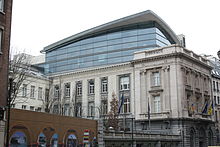
The Brussels-Capital Region is governed by aparliamentof 89 members (72 French-speaking, 17 Dutch-speaking—parties are organised on a linguistic basis) and an eight-member regional cabinet consisting of aminister-president,four ministers and threestate secretaries.By law, the cabinet must comprise two French-speaking and two Dutch-speaking ministers, one Dutch-speaking secretary of state and two French-speaking secretaries of state. The minister-president does not count against the language quota, but in practice every minister-president has been a bilingual francophone. The regional parliament can enactordinances(French:ordonnances,Dutch:ordonnanties), which have equal status as a national legislative act.
Nineteen of the 72 French-speaking members of the Brussels Parliament are also members of theParliament of the French Community of Belgium,and, until 2004, this was also the case for six Dutch-speaking members, who were at the same time members of theFlemish Parliament.Now, people voting for a Flemish party have to vote separately for 6 directly elected members of the Flemish Parliament.
Agglomeration of Brussels
[edit]Before the creation of the Brussels-Capital Region, regional competences in the 19 municipalities were performed by the Brussels Agglomeration. The Brussels Agglomeration was an administrative division established in 1971. This decentralised administrative public body also assumed jurisdiction over areas which, elsewhere in Belgium, were exercised by municipalities or provinces.[123]
The Brussels Agglomeration had a separate legislative council, but the by-laws enacted by it did not have the status of a legislative act. The only election of the council took place on 21 November 1971. The working of the council was subject to many difficulties caused by the linguistic and socio-economic tensions between the two communities.
After the creation of the Brussels-Capital Region, the Brussels Agglomeration was never formally abolished, although it no longer has a purpose.
French and Flemish communities
[edit]
TheFrench Communityand theFlemish Communityexercise their powers in Brussels through two community-specific public authorities: theFrench Community Commission(French:Commission communautaire françaiseor COCOF) and theFlemish Community Commission(Dutch:Vlaamse Gemeenschapscommissieor VGC). These two bodies each have an assembly composed of the members of each linguistic group of theParliament of the Brussels-Capital Region.They also have a board composed of the ministers and secretaries of state of each linguistic group in the Government of the Brussels-Capital Region.
The French Community Commission also has another capacity: some legislative powers of the French Community have been devolved to the Walloon Region (for the French language area of Belgium) and to the French Community Commission (for the bilingual language area).[124]The Flemish Community, however, did the opposite; it merged the Flemish Region into the Flemish Community.[125]This is related to different conceptions in the two communities, one focusing more on the Communities and the other more on the Regions, causing an asymmetricalfederalism.Because of this devolution, the French Community Commission can enactdecrees,which are legislative acts.
Common Community Commission
[edit]A bi-communitarian public authority, theCommon Community Commission(French:Commission communautaire commune,COCOM, Dutch:Gemeenschappelijke Gemeenschapscommissie,GGC) also exists. Its assembly is composed of the members of the regional parliament, and its board are the ministers—not the secretaries of state—of the region, with the minister-president not having the right to vote. This commission has two capacities: it is a decentralised administrative public body, responsible for implementing cultural policies of common interest. It can give subsidies and enactby-laws.In another capacity, it can also enact ordinances, which have equal status as a national legislative act, in the field of the welfare powers of the communities: in the Brussels-Capital Region, both the French Community and the Flemish Community can exercise powers in the field of welfare, but only in regard to institutions that are unilingual (for example, a private French-speaking retirement home or the Dutch-speaking hospital of theVrije Universiteit Brussel). The Common Community Commission is responsible for policies aiming directly at private persons or at bilingual institutions (for example, the centres for social welfare of the 19 municipalities). Its ordinances have to be enacted with a majority in both linguistic groups. Failing such a majority, a new vote can be held, where a majority of at least one third in each linguistic group is sufficient.
Brussels and the European Union
[edit]
Brussels serves asde factocapital of theEuropean Union(EU), hosting the major politicalinstitutions of the Union.[1]The EU has not declared a capital formally, though theTreaty of Amsterdamformally gives Brussels the seat of theEuropean Commission(the executive branch of government) and theCouncil of the European Union(a legislative institution made up from executives of member states).[126][full citation needed][127][full citation needed]It locates the formal seat ofEuropean ParliamentinStrasbourg,where votes take place, with the council, on the proposals made by the commission. However, meetings of political groups and committee groups are formally given to Brussels, along with a set number of plenary sessions. Three quarters of Parliament sessions now take place at itsBrussels hemicycle.[128]Between 2002 and 2004, theEuropean Councilalso fixed its seat in the city.[129]In 2014, the Union hosted aG7 summitin the city.[92]

Brussels, along withLuxembourgand Strasbourg, began to host European institutions in 1957, soon becoming the centre of activities, as the Commission and Council based their activities in what has become theEuropean Quarter,in the east of the city.[126]Early building in Brussels was sporadic and uncontrolled, with little planning. The current major buildings are theBerlaymont buildingof the commission, symbolic of the quarter as a whole, theEuropa buildingof the Council and theEspace Léopoldof the Parliament.[127]Nowadays, the presence has increased considerably, with the Commission alone occupying 865,000 m2(9,310,000 sq ft) within the European Quarter (a quarter of the total office space in Brussels).[1]The concentration and density has caused concern that the presence of the institutions has created aghettoeffectin that part of the city.[130]However, the European presence has contributed significantly to the importance of Brussels as an international centre.[131]
International institutions
[edit]Brussels has, sinceWorld War II,become the administrative centre of many international organisations. The city is the political and administrative centre of theNorth Atlantic Treaty Organization(NATO).NATO's Brussels headquartershouses29 embassiesand brings together over 4,500 staff from allied nations, their militaries, and civil service personnel. Many other international organisations such as theWorld Customs OrganizationandEurocontrol,as well as international corporations, have their main institutions in the city. In addition, the main internationaltrade unionconfederations have their headquarters there: theEuropean Trade Union Confederation(ETUC), theInternational Confederation of Free Trade Unions(ICFTU) and theWorld Confederation of Labour(WCL).
Brussels is third in the number of international conferences it hosts,[132]also becoming one of the largest convention centres in the world.[133]The presence of the EU and the other international bodies has, for example, led to there being more ambassadors and journalists in Brussels than inWashington, D.C.[131]The city hosts 120 international institutions, 181embassies(intra muros) and more than 2,500diplomats,making it the second centre of diplomatic relations in the world (afterNew York City).International schoolshave also been established to serve this presence.[133]The "international community" in Brussels numbers at least 70,000 people.[134]In 2009, there were an estimated 286lobbyingconsultancies known to work in Brussels.[135]Finally, Brussels has more than 1,400NGOs.[136][137]
North Atlantic Treaty Organization
[edit]
TheTreaty of Brussels,which was signed on 17 March 1948 between Belgium,France,Luxembourg,theNetherlandsand theUnited Kingdom,was a prelude to the establishment of theintergovernmentalmilitary alliancewhich later became the North Atlantic Treaty Organization (NATO).[138]Nowadays, the alliance consists of 32 independent member countries acrossNorth Americaand Europe. Several countries also have diplomatic missions to NATOthrough embassies in Belgium.Since 1949, a number ofNATO Summitshave been held in Brussels,[139]the most recent taking place in June 2021.[95]The organisation's political and administrativeheadquartersare located on theBoulevard Léopold III/Leopold III-laaninHaren,on the north-eastern perimeter of theCity of Brussels.[140]A new €750 million headquarters building begun in 2010 and was completed in 2017.[141]
Eurocontrol
[edit]The European Organisation for the Safety of Air Navigation, commonly known as Eurocontrol, is aninternational organisationwhich coordinates and plansair traffic controlacross Europeanairspace.The corporation was founded in 1960 and has 41 member states.[142]Its headquarters are located in Haren, Brussels.
Demographics
[edit]Population
[edit]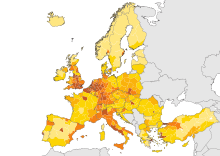
Brussels is located in one of the mosturbanised regions of Europe,betweenParis,London,theRhine-Ruhr(Germany), and theRandstad(Netherlands). The Brussels-Capital Region has a population of around 1.2 million and has witnessed, in recent years, a remarkable increase in its population. In general, the population of Brussels is younger than the national average, and the gap between rich and poor is wider.[143]
Brussels is the core of a built-up area that extends well beyond the region's limits. Sometimes referred to as the urban area of Brussels (French:aire urbaine de Bruxelles,Dutch:stedelijk gebied van Brussel) or Greater Brussels (French:Grand-Bruxelles,Dutch:Groot-Brussel), this area extends over a large part of the two Brabant provinces, including much of the surroundingarrondissement of Halle-Vilvoordeand some small parts of thearrondissement of LeuveninFlemish Brabant,as well as the northern part ofWalloon Brabant.
The metropolitan area of Brussels is divided into three levels. Firstly, the central agglomeration (within the regional borders), with a population of 1,218,255 inhabitants.[32]Adding the closest suburbs (French:banlieues,Dutch:buitenwijken) gives a total population of 1,831,496. Including the outercommuterzone (Brussels Regional Express Network(RER/GEN) area), the population is 2,676,701.[34][35]Brussels is also part of a widerdiamond-shapedconurbation,withGhent,AntwerpandLeuven,which has about 4.4 million inhabitants (a little more than 40% of the Belgium's total population).[36][144]
| [verification needed] | 01-07-2004[145] | 01-07-2005[145] | 01-07-2006[145] | 01-01-2008[145] | 01-01-2015[145] | 01-01-2019[145] | 01-01-2020[145] |
|---|---|---|---|---|---|---|---|
| Brussels-Capital Region[145][verification needed] | 1.004.239 | 1.012.258 | 1.024.492 | 1.048.491 | 1.181.272 | 1.208.542 | 1.218.255 |
| -- of which legal immigrants[145][verification needed] | 262.943 | 268.009 | 277.682 | 295.043 | 385.381 | 450.000 | ? |
Nationalities
[edit]| 68,418 | |||||||||||||||||||||||
| 45,243 | |||||||||||||||||||||||
| 35,154 | |||||||||||||||||||||||
| 33,955 | |||||||||||||||||||||||
| 30,609 | |||||||||||||||||||||||
| 20,060 | |||||||||||||||||||||||
| 18,968 | |||||||||||||||||||||||
| 13,104 | |||||||||||||||||||||||
| 10,927 | |||||||||||||||||||||||
| 9,675 | |||||||||||||||||||||||
| |||||||||||||||||||||||
There have been numerous migrations towards Brussels since the end of the 18th century, when the city acted as a common destination forpolitical refugeesfrom neighbouring or more distant countries, particularly France.[147]From 1871, many of theParis Communardsfled to Brussels, where they received political asylum. Other notable international exiles living in Brussels at the time includedVictor Hugo,Karl Marx,Pierre-Joseph Proudhon,Georges Boulanger,Paul Verlaine,Arthur Rimbaud,andLéon Daudet,to name a few.[147][148]Attracted by the industrial opportunities, many workers moved in, first from the otherBelgian provinces(mainly rural residents fromFlanders)[149]and France, then fromSouthern European,and more recently fromEastern EuropeanandAfricancountries.
Nowadays, Brussels is home to a large number of immigrants andémigrécommunities, as well as labour migrants, former foreign students orexpatriates,and many Belgian families in Brussels can claim at least one foreign grandparent. At the last Belgian census in 1991, 63.7% of inhabitants in Brussels-Capital Region answered that they were Belgian citizens, born as such in Belgium, indicating that more than a third of residents had not been born in the country.[150][151]According toStatbel(the Belgian Statistical Office), in 2020, taking into account the nationality of birth of the parents, 74.3% of the population of the Brussels-Capital Region was of foreign origin and 41.8% was of non-European origin (including 28.7% of African origin). Among those aged under 18, 88% were of foreign origin and 57% of non-European origin (including 42.4% of African origin).[7]
This large concentration of immigrants and their descendants includes many ofMoroccan(mainlyRiffianand otherBerbers) andTurkishancestry, together with French-speaking black Africans from formerBelgian colonies,such as theDemocratic Republic of the Congo,RwandaandBurundi.Many immigrants werenaturalisedfollowing the great 1991 reform of the naturalisation process. In 2012, about 32% of city residents were of non-BelgianEuropeanorigin (mainly expatriates from France, Romania, Italy, Spain, Poland, and Portugal) and 36% were of another background, mostly from Morocco, Turkey andSub-Saharan Africa.Among all major migrant groups from outside the EU, a majority of the permanent residents have acquired Belgian nationality.[152]
Languages
[edit]
Brussels was historicallyDutch-speaking,using theBrabantian dialect,[154][155][156]but since the 19th century[154][157]Frenchhas become the predominant language of the city.[158]The main cause of this transition was the rapidassimilationof the localFlemish population,[159][154][160][161][156]amplified by immigration fromFranceandWallonia.[154][162]Therise of Frenchin public life gradually began by the end of the 18th century,[163][164]quickly accelerating afterBelgian independence.[165][166]Dutch — of whichstandardisationin Belgium was still very weak[167][168][166]— could not compete with French, which was the exclusive language of the judiciary, the administration, the army, education, cultural life and the media, and thus necessary forsocial mobility.[169][170][155][171][157]The value and prestige of the French language was universally acknowledged[155][172][159][166][173][174]to such an extent that after 1880,[175][176][167]and more particularly after the turn of the 20th century,[166]proficiency in French among Dutch-speakers in Brussels increased spectacularly.[177]
Although a majority of the population remained bilingual until the second half of the 20th century,[177][159]family transmission of the historic Brabantian dialect[178]declined,[179]leading to an increase of monolingual French-speakers from 1910 onwards.[172][180]From the mid-20th century, the number of monolingual French-speakers surpassed the number of mostly bilingual Flemish inhabitants.[181]This process of assimilation weakened after the 1960s,[177][182]as thelanguage borderwas fixed, the status of Dutch as an official language of Belgium was reinforced,[183]and the economic centre of gravity shifted northward toFlanders.[167][175]However, with the continuing arrival of immigrants and the post-war emergence of Brussels as acentre of international politics,the relative position of Dutch continued to decline.[184][157][185][186][177][179]Furthermore, as Brussels' urban area expanded,[187]a further number of Dutch-speaking municipalities in theBrussels peripheryalso became predominantly French-speaking.[183][188]This phenomenon of expanding Francisation — dubbed "oil slick" by its opponents[159][189][177]— is, together with the future of Brussels,[190]one of the most controversial topics inBelgian politics.[175][170]
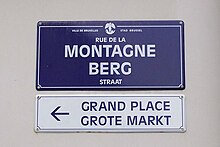
Nowadays, the Brussels-Capital Region is legally bilingual, with both French and Dutch having official status,[191]as is the administration of the 19 municipalities.[184]The creation of this bilingual, full-fledged region, with its own competencies and jurisdiction, had long been hampered by different visions of Belgian federalism. Nevertheless, some communitarian issues remain.[192][193]Flemish political parties demanded, for decades, that the Flemish part ofBrussels-Halle-Vilvoorde(BHV)arrondissementbe separated from the Brussels Region (which made Halle-Vilvoorde a monolingual Flemish electoral and judicial district). BHV was divided mid-2012. The French-speaking population regards the language border as artificial[194]and demands the extension of the bilingual region to at least all sixmunicipalities with language facilitiesin the surroundings of Brussels.[d]Flemish politicians have strongly rejected these proposals.[195][196][197]

Owing to migration and to its international role, Brussels is home to a large number of native speakers of languages other than French or Dutch. Currently, about half of the population speaks a home language other than these two.[198]In 2013, academic research showed that approximately 17% of families spoke none of the official languages in the home, while in a further 23% a foreign language was used alongside French. The share of unilingual French-speaking families had fallen to 38% and that of Dutch-speaking families to 5%, while the percentage of bilingual Dutch-French families reached 17%. At the same time, French remains widely spoken: in 2013, French was spoken "well to perfectly" by 88% of the population, while for Dutch this percentage was only 23% (down from 33% in 2000);[184]the other most commonly known languages were English (30%), Arabic (18%), Spanish (9%), German (7%) and Italian and Turkish (5% each).[153]Despite the rise of English as a second language in Brussels, including as an unofficial compromise language between French and Dutch, as well as the working language for some of its international businesses and institutions, French remains thelingua francaand all public services are conducted exclusively in French or Dutch.[184]
The original dialect of Brussels (known asBrusselian,and also sometimes referred to as Marols or Marollien),[51]a form ofBrabantic(the variant of Dutch spoken in the ancientDuchy of Brabant) with a significant number of loanwords from French, still survives among a small minority of inhabitants calledBrusseleers[52](orBrusseleirs), many of them quite bi- and multilingual, or educated in French and not writing in Dutch.[199][51]The ethnic and national self-identification of Brussels' inhabitants is nonetheless sometimes quite distinct from the French and Dutch-speaking communities. For the French-speakers, it can vary from Francophone Belgian,Bruxellois[54](Frenchdemonymfor an inhabitant of Brussels),Walloon(for people who migrated from the Walloon Region at an adult age); for Flemings living in Brussels, it is mainly either Dutch-speaking Belgian, Flemish orBrusselaar(Dutch demonym for an inhabitant), and often both. For theBrusseleers,many simply consider themselves as belonging to Brussels.[51]
Religions
[edit]Religions in the Brussels-Capital Region (2016)[200]
Historically, Brussels has been predominantlyCatholic,especially since the expulsion ofProtestantsin the 16th century. This is clear from the large number of historical churches in the region, particularly in theCity of Brussels.The pre-eminent Catholiccathedralin Brussels is theCathedral of St. Michael and St. Gudula,serving as theco-cathedralof theArchdiocese of Mechelen–Brussels.On the north-western side of the region, theNational Basilica of the Sacred Heartis aMinor Basilicaandparish church,as well as one of thelargest churches by area in the world.[201]TheChurch of Our Lady of Laekenholds the tombs of many members of theBelgian royal family,including all the formerBelgian monarchs,within theRoyal Crypt.[202][203]
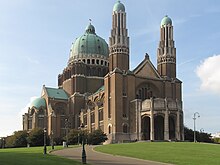
In reflection of its multicultural makeup, Brussels hosts a variety of religious communities, as well as large numbers ofatheistsandagnostics.Minority faiths includeIslam,Anglicanism,Eastern Orthodoxy,Judaism,andBuddhism.According to a 2016 survey, approximately 40% of residents of Brussels declared themselves Catholics (12% were practising Catholics and 28% were non-practising Catholics), 30% werenon-religious,23% wereMuslim(19% practising, 4% non-practising), 3% were Protestants and 4% were of another religion.[200]
As guaranteed by Belgian law, recognised religions and non-religious philosophical organisations (French:organisations laïques,Dutch:vrijzinnige levensbeschouwelijke organisaties)[204]enjoy public funding and school courses. It was once the case that every pupil in an official school from 6 to 18 years old had to choose two hours per week of compulsory religious—or non-religious-inspired morals—courses. However, in 2015, theBelgian Constitutional Courtruled religious studies could no longer be required in theprimaryandsecondaryeducational systems.[205]
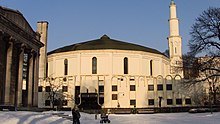
Brussels has a large concentration ofMuslims,mostly of Moroccan, Turkish, Syrian and Guinean ancestry. TheGreat Mosque of Brussels,located in theParc du Cinquantenaire/Jubelpark,is the oldestmosquein Brussels and the former seat of the Islamic and Cultural Centre of Belgium.[206]Belgium does not collect statistics by ethnic background or religious beliefs, so exact figures are unknown.[207]It was estimated that, in 2005, people of Muslim background living in the Brussels Region numbered 256,220 and accounted for 25.5% of the city's population, a much higher concentration than those of the other regions of Belgium.[208][better source needed]
| Regions of Belgium[208](1 January 2016) | Total population | People of Muslim origin | % of Muslims |
|---|---|---|---|
| Belgium | 11,371,928 | 603,642 | 5.3% |
| Brussels-Capital Region | 1,180,531 | 212,495 | 18% |
| Wallonia | 3,395,942 | 149,421 | 4.4% |
| Flanders | 6,043,161 | 241,726 | 4.0% |
Architecture
[edit]The architecture in Brussels is diverse, and spans from the clashing combination ofGothic,Baroque,andLouis XIVstyles on theGrand-Placeto thepostmodernbuildings of theEU institutions.[209]

Very littlemedieval architectureis preserved in Brussels. Buildings from that period are mostly found in the historical centre (calledÎlot Sacré),Saint Géry/Sint-GoriksandSainte-Catherine/Sint Katelijneneighbourhoods. TheBrabantine GothicCathedral of St. Michael and St. Gudularemains a prominent feature in the skyline of downtown Brussels. Isolated portions of thefirst city wallswere saved from destruction and can be seen to this day. One of the only remains of thesecond wallsis theHalle Gate.The Grand-Place is the main attraction in the city centre and has been aUNESCO World Heritage Sitesince 1998.[210]The square is dominated by the 15th centuryFlamboyantTown Hall,theneo-GothicBreadhouseand the Baroqueguildhallsof the formerGuilds of Brussels.Manneken Pis,a fountain containing a smallbronzesculpture of a urinating youth, is a tourist attraction andsymbolof the city.[211]

Theneoclassicalstyle of the 18th and 19th centuries is represented in the Royal Quarter/Coudenberg area, aroundBrussels Parkand thePlace Royale/Koningsplein.Examples include theRoyal Palace,theChurch of St. James on Coudenberg,thePalace of the Nation(Parliament building), theAcademy Palace,thePalace of Charles of Lorraine,thePalace of the Count of Flandersand theEgmont Palace.Other uniform neoclassical ensembles can be found around thePlace des Martyrs/Martelaarspleinand thePlace de Barricades/Barricadenplein.Some additional landmarks in the centre are theRoyal Saint-Hubert Galleries(1847), one of the oldest covered shopping arcades in Europe, theCongress Column(1859), the formerBrussels Stock Exchangebuilding (1873) and thePalace of Justice(1883). The latter, designed byJoseph Poelaert,ineclecticstyle, is reputed to be the largest building constructed in the 19th century.[212]
Located outside the historical centre, in a greener environment bordering theEuropean Quarter,are theParc du Cinquantenaire/Jubelparkwith itsmemorial arcadeand nearby museums, and inLaeken,theRoyal Palace of Laekenand the Royal Domain with its largegreenhouses,as well as theMuseums of the Far East.
Also particularly striking are the buildings in theArt Nouveaustyle, most famously by the Belgian architectsVictor Horta,Paul HankarandHenry Van de Velde.[213][214]Some of Brussels' municipalities, such asSchaerbeek,Etterbeek,Ixelles,andSaint-Gilles,were developed during the heyday of Art Nouveau and have many buildings in that style. TheMajor Town Houses of the Architect Victor Horta—Hôtel Tassel(1893),Hôtel van Eetvelde(1898),Hôtel Solvay(1900) and theHorta Museum(1901)—have been listed as aUNESCOWorld Heritage Sitesince 2000.[83]Another example of Brussels' Art Nouveau is theStoclet Palace(1911), by the Viennese architectJosef Hoffmann,designated a World Heritage Site by UNESCO in June 2009.[215]
- Art Nouveau in Brussels
-
Hôtel TasselbyVictor Horta(1893)
-
Stairway in the Hôtel Tassel
-
FormerOld Englanddepartment store byPaul Saintenoy(1899)
-
Saint-Cyr HousebyGustave Strauven(1903)
-
Cauchie HousebyPaul Cauchie(1905)
-
Sgraffitopanel in the Cauchie House
-
Stoclet PalacebyJosef Hoffmann(1911)

Art Decostructures in Brussels include the Résidence Palace (1927) (now part of theEuropa building), theCentre for Fine Arts(1928), theVilla Empain(1934), theTown Hall of Forest(1938), and theFlagey Building(formerly known as theMaison de la Radio) on thePlace Eugène Flagey/Eugène Flageyplein(1938) in Ixelles. Some religious buildings from theinterwar erawere also constructed in that style, such as theChurch of St. John the Baptist(1932) in Molenbeek and theChurch of St. Augustine(1935) in Forest. Completed only in 1969, and combining Art Deco withneo-Byzantineelements, theBasilica of the Sacred HeartinKoekelbergis one of thelargest churches by area in the world,and itscupolaprovides a panoramic view of Brussels and its outskirts. Another example are the exhibition halls of the Centenary Palace, built for the1935 World's Fairon theHeysel/Heizel Plateauin northern Brussels, home to the Brussels Exhibition Centre (Brussels Expo).[216]
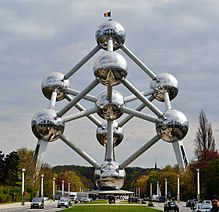
TheAtomiumis a symbolic 103 m-tall (338 ft)moderniststructure, located on the Heysel Plateau, which was originally built for the 1958 World's Fair (Expo 58). It consists of nine steel spheres connected by tubes, and forms a model of anironcrystal(specifically, aunit cell), magnified 165 billion times. The architectAndré Waterkeyndevoted the building to science. It is now considered alandmarkof Brussels.[217][218]Next to the Atomium, isMini-Europeminiature park,with 1:25 scalemaquettesof famous buildings from across Europe.
Since the second half of the 20th century, modern office towers have been built in Brussels (Madou Tower,Rogier Tower,Proximus Towers,Finance Tower,theWorld Trade Center,among others). There are some thirty towers, mostly concentrated in the city'smain business district:theNorthern Quarter(also calledLittle Manhattan), nearBrussels-North railway station.TheSouth Tower,standing adjacent toBrussels-South railway station,is thetallest building in Belgium,at 148 m (486 ft). Along theNorth–South connection,is the State Administrative City, an administrative complex in theInternational Style.The postmodern buildings of theEspace Léopoldcomplete the picture.
The city's embrace of modern architecture translated into an ambivalent approach towards historic preservation, leading to the destruction of notable architectural landmarks, most famously theMaison du Peuple/Volkshuisby Victor Horta, a process known asBrusselisation.[86][87]
Culture
[edit]Visual arts and museums
[edit]
Brusselscontains over 80 museums.[219]TheRoyal Museums of Fine Artshas an extensive collection of various painters, such asFlemish old masterslikeBruegel,Rogier van der Weyden,Robert Campin,Anthony van Dyck,Jacob Jordaens,andPeter Paul Rubens.TheMagritte Museumhouses the world's largest collection of the works of thesurrealistRené Magritte.Museums dedicated to the national history of Belgium include theBELvue Museum,theRoyal Museums of Art and History,and theRoyal Museum of the Armed Forces and Military History.TheMusical Instruments Museum(MIM), housed in theOld Englandbuilding, is part of the Royal Museums of Art and History, and is internationally renowned for its collection of over 8,000 instruments.
The Brussels Museums Council is an independent body for all the museums in the Brussels-Capital Region, covering around 100 federal, private, municipal, and community museums.[220]It promotes member museums through the Brussels Card (giving access to public transport and 30 of the 100 museums), the Brussels Museums Nocturnes (every Thursday from 5 p.m. to 10 p.m. from mid-September to mid-December) and the Museum Night Fever (an event for and by young people on a Saturday night in late February or early March).[221]
Brussels has had a distinguished artist scene for many years. The famous Belgian surrealistsRené MagritteandPaul Delvaux,for instance, studied and lived there, as did theavant-gardedramatistMichel de Ghelderode.The city was also home of theimpressionistpainterAnna Bochfrom the artists' groupLes XX,and includes other famous Belgian painters such asLéon Spilliaert.Brussels is also a capital of thecomic strip;[3]some treasured Belgian characters areTintin,Lucky Luke,The Smurfs,Spirou,Gaston,Marsupilami,Blake and Mortimer,Boule et BillandCubitus(seeBelgian comics). Throughout the city, walls are painted with large motifs of comic book characters; thesemuralstaken together are known asBrussels' Comic Book Route.[46]Also, the interiors of someMetro stationsare designed by artists. TheBelgian Comic Strip Centercombines two artistic leitmotifs of Brussels, being a museum devoted to Belgian comic strips, housed in the formerMagasins Waucqueztextile department store, designed byVictor Hortain theArt Nouveaustyle. In addition,street artis changing the landscape of this multicultural city.[222]
Performing arts venues and festivals
[edit]
Brussels is well known for itsperforming artsscene, with theRoyal Theatre of La Monnaie,theRoyal Park Theatre,theThéâtre Royal des Galeries,and theKaaitheateramong the most notable institutions.
TheKunstenfestivaldesarts,an international performing arts festival, is organised every year in May. Its main hub is the Kaaitheater, but performances and artworks are also hosted in around 30 venues throughout the city.[223][224]
TheKing Baudouin Stadiumis a concert and competition facility with a 50,000 seat capacity, the largest in Belgium. The site was formerly occupied by theHeysel Stadium.TheCentre for Fine Arts(often referred to as BOZAR in French or PSK in Dutch), a multi-purpose centre for theatre, cinema, music, literature, and art exhibitions, is home to theNational Orchestra of Belgiumand to the annualQueen Elisabeth Competitionforclassicalsingers and instrumentalists, one of the most challenging and prestigious competitions of the kind. Studio 4 inLe Flageycultural centre hosts theBrussels Philharmonic.[225][226]
Other concert venues includeForest National/Vorst Nationaal,theAncienne Belgique,theCirque Royal/Koninklijk Circus,theBotaniqueandPalais 12/Paleis 12.Furthermore, theJazz StationinSaint-Josse-ten-Noodeis a museum and archive onjazz,and a venue for jazz concerts.[227]
Other cultural events and festivals
[edit]
Many events are organised or hosted in Brussels throughout the year. In addition, many festivals animate the Brussels scene.
TheIris Festivalis the official festival of the Brussels-Capital Region and is held annually in spring.[228]The International Fantastic Film Festival of Brussels (BIFFF) is organised during the Easter holidays[229]and theMagritte Awardsin February. TheFestival of Europe,an open day and activities in and around the institutions of theEuropean Union,is held on 9 May. OnBelgian National Day,on 21 July, a military parade and celebrations take place on thePlace des Palais/Paleizenpleinand inBrussels Park,ending with a fireworks display in the evening.
Some summer festivities includeCouleur Café Festival,a festival ofworldandurban music,around the end of June or early July, theBrussels Summer Festival(BSF), a music festival in August,[230]theMidi Fair,the most important yearly fair in Brussels, lasting more than a month, in July and August,[231]and Brussels Beach, when the banks of thecanalare turned into a temporary urban beach.[232]Other biennial events are theZinneke Parade,a colourful, multicultural parade through the city, which has been held since 2000 in May, as well as the popularFlower Carpetat theGrand-Placein August.Heritage Daysare organised on the third weekend of September (sometimes coinciding with the car-free day) and are a good opportunity to discover the wealth of buildings, institutions and real estate in Brussels. The "Winter Wonders" animate the heart of Brussels in December; these winter activities were launched in Brussels in 2001.[233][234]
Folklore
[edit]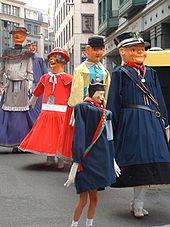
Brussels' identity owes much to its rich folklore and traditions, among the liveliest in the country.[235][236]
TheOmmegang,a folkloric costumed procession, commemorating theJoyous EntryofEmperor Charles Vand his sonPhilip IIin the city in 1549, takes place every year in July. The colourful parade includes floats, traditional processional giants, such asSaint MichaelandSaint Gudula,and scores of folkloric groups, either on foot or on horseback, dressed in medieval garb. The parade ends in apageanton theGrand-Place.Since 2019, it has been recognised as aMasterpiece of the Oral and Intangible Heritage of HumanitybyUNESCO.[237]
TheMeyboom,an even-older folk tradition of Brussels (1308), celebrating the "May tree"—in fact, a corruption of the Dutchtree of joy—takes place paradoxically on 9 August. After parading a youngbeechin the city, it is planted in a joyful spirit with lots of music,Brusseleirsongs, and processional giants. It has also been recognised as an expression ofintangible cultural heritageby UNESCO, as part of the bi-national inscription "Processional giants and dragons in Belgium and France".[238][239]The celebration is reminiscent of the town's long-standing (folkloric) feud withLeuven,which dates back to theMiddle Ages.
TheSaint-Verhaegen/Sint-Verhaegen(often shortened toSt V), a folkloric student procession, celebrating the anniversary of the founding of theUniversité libre de Bruxelles(ULB) and theVrije Universiteit Brussel(VUB), is held on 20 November. Since 2019, it has also been listed as intangible cultural heritage of the Brussels-Capital Region.[240][241][242]
Another good introduction to theBrusseleirlocal dialectand way of life can be obtained at theRoyal Theatre Toone,a folkloric theatre ofmarionettes,located a stone's throw away from the Grand-Place.[243]Finally, two famous folkloric plays,Le Mariage de Mademoiselle Beulemansby Frantz Fonson and Fernand Wicheler, andBossemans et Coppenolleby Joris d'Hanswyck and Paul Van Stalle, are still the subject of regular revivals.[244]
Cuisine
[edit]
Brussels is well known for its localwaffle,itschocolate,itsFrench friesand its numerous types ofbeers.TheBrussels sprout,which has long been popular in Brussels, and may have originated there, is also named after the city.[245]
Owing to Brussels' cosmopolitan population, almost every national cuisine in the world can be found there. The gastronomic offer includes approximately 1,800restaurants(including three 2-starred and ten 1-starredMichelinrestaurants),[246]and a number of bars. In addition to the traditional restaurants, there are manycafés,bistrosand the usual range of internationalfast foodchains. The cafés are similar to bars, and offer beer and light dishes;coffee housesare calledsalons de thé(literally "tea salons" ). Also widespread arebrasseries,which usually offer a variety of beers and typical national dishes.
Belgian cuisineis known among connoisseurs as one of the best in Europe. It is characterised by the combination ofFrench cuisinewith the more hearty Flemish fare. Notable specialities includeBrussels waffles(gaufres) andmussels(usually asmoules-frites,served with fries). The city is a stronghold ofchocolateandpralinemanufacturers with renowned companies likeCôte d'Or,Neuhaus,LeonidasandGodiva.Pralines were first introduced in 1912 by Jean Neuhaus II, a Belgianchocolatierof Swiss origin, in theRoyal Saint-Hubert Galleries.[247]Numerousfriteriesare spread throughout the city, and in tourist areas, fresh hot waffles are also sold on the street.
As well as otherBelgian beers,thespontaneously fermentedlambicstyle, brewed in and around Brussels, is widely available there and in the nearbySennevalley where the wildyeaststhat ferment it have their origin.[248]Kriek,a cherry lambic, is available in almost every bar or restaurant in Brussels.
Brussels is known as the birthplace of theBelgian endive.The technique for growingblanchedendives was accidentally discovered in the 1850s at theBotanical Garden of BrusselsinSaint-Josse-ten-Noode.[249]
Shopping
[edit]
Famousshoppingareas in Brussels include the pedestrian-onlyRue Neuve/Nieuwstraat,the second busiest shopping street in Belgium (after theMeir,inAntwerp) with a weekly average of 230,000 visitors,[250][251]home to popular international chains (H&M,C&A,Zara,Primark), as well as the City 2 and Anspach galleries.[252]TheRoyal Saint-Hubert Gallerieshold a variety of luxury shops and some six million people stroll through them each year.[253]The neighbourhood around theRue Antoine Dansaert/Antoine Dansaertstraathas become, in recent years, a focal point for fashion and design;[254]this main street and its side streets also feature Belgium's young and most happening artistic talent.[255]
In Ixelles, theAvenue de la Toison d'Or/Gulden-Vlieslaanand theNamur Gatearea offer a blend of luxury shops, fast food restaurants and entertainment venues, and theChaussée d'Ixelles/Elsenesteenweg,in the mainly-CongoleseMatongédistrict, offers a taste ofAfrican fashionand lifestyle. The nearbyAvenue Louise/Louizalaanis lined with high-end fashion stores and boutiques, making it one of the most expensive streets in Belgium.[256]
There are shopping centres outside the inner ring: Basilix, Woluwe Shopping Center, Westland Shopping Center, and Docks Bruxsel, which opened in October 2017.[252]In addition, Brussels ranks as one of Europe's best capital cities forflea marketshopping. TheOld Market,on thePlace du Jeu de Balle/Vossenplein,in theMarolles/Marollenneighbourhood, is particularly renowned.[257]The nearbySablon/Zavelarea is home to many of Brussels'antiquedealers.[258]TheMidi MarketaroundBrussels-South stationand theBoulevard du Midi/Zuidlaanis reputed to be one of the largest markets in Europe.[259]
Sports
[edit]
Sport in Brussels is under the responsibility of theCommunities.TheAdministration de l'Éducation Physique et du Sport(ADEPS) is responsible for recognising the various French-speaking sports federations and also runs three sports centres in the Brussels-Capital Region.[260]Its Dutch-speaking counterpart isSport Vlaanderen(formerly calledBLOSO).[261]
TheKing Baudouin Stadium(formerly the Heysel Stadium) is the largest in the country and home to the national teams infootballandrugby union.[262]It hosted the final of the1972 UEFA European Football Championship,and the opening game ofthe 2000 edition.Several European club finals have been held at the ground, including the1985 European Cup Finalwhich saw 39 deaths due to hooliganism and structural collapse.[263]The King Baudouin Stadium is also home of the annualMemorial Van Dammeathletics event, Belgium's foremosttrack and fieldcompetition, which is part of theDiamond League.Other important athletics events are theBrussels Marathon[264]and the20 km of Brussels,an annual run with 30,000 participants.[265]
Football
[edit]
R.S.C. Anderlecht,based in theConstant Vanden Stock StadiuminAnderlecht,is the most successful Belgian football club in theBelgian Pro League,with 34 titles.[266]It has also won the most major European tournaments for a Belgian side, with 6 European titles. Brussels is also home toUnion Saint-Gilloise,the most successful Belgian club before World War II, with 11 titles.[267]The club was founded inSaint-Gillesbut is based in nearbyForest,and plays in the Belgian Pro League.Racing White Daring Molenbeek,based inMolenbeek-Saint-Jean,and often referred to as RWDM, is a very popular football club that, since 2023, is back playing in the Belgian Pro League.[268][269]
Other Brussels clubs that played in the national series over the years wereRoyal White Star Bruxelles,Ixelles SC,Crossing Club de Schaerbeek(born from a merger between RCS de Schaerbeek and Crossing Club Molenbeek), Scup Jette, RUS de Laeken, Racing Jet de Bruxelles, AS Auderghem, KV Wosjot Woluwe and FC Ganshoren.
Cycling
[edit]Brussels is home to notablecycling races.The city is the arrival location of theBrussels Cycling Classic,formerly known as Paris–Brussels, which is one of the oldestsemi classicbicycle raceson the international calendar.[270]From World War I until the early 1970s, theSix Days of Brusselswas organised regularly. In the last decades of the 20th century, theGrand Prix Eddy Merckxwas also held in Brussels.
Economy
[edit]
Serving as the centre of administration for Belgium and Europe, Brussels' economy is largelyservice-oriented. It is dominated by regional and world headquarters ofmultinationals,by European institutions, by various local and federal administrations, and by related services companies, though it does have a number of notablecraftindustries, such as theCantillon Brewery,alambicbrewery founded in 1900.[271]
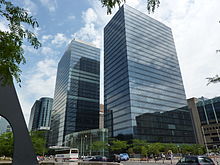
Brussels has a robust economy. The region contributes to one fifth of Belgium'sGDP,and its 550,000 jobs account for 17.7% of Belgium's employment.[272]ItsGDP per capitais nearly double that of Belgium as a whole,[30]and it has the highest GDP per capita of anyNUTS 1region in the EU, at ~$80,000 in 2016.[273]That being said, the GDP is boosted by a massive inflow ofcommutersfrom neighbouring regions; over half of those who work in Brussels live in Flanders or Wallonia, with 230,000 and 130,000 commuters per day respectively. Conversely, only 16.0% of people from Brussels work outside Brussels (68,827 (68.5%) of them in Flanders and 21,035 (31.5%) in Wallonia).[274]Not all of the wealth generated in Brussels remains in Brussels itself, and as of December 2013[update],the unemployment among residents of Brussels is 20.4%.[275]
There are approximately 50,000businessesin Brussels, of which around 2,200 are foreign. This number is constantly increasing and can well explain the role of Brussels in Europe. The city'sinfrastructureis very favourable in terms of starting up a new business. House prices have also increased in recent years, especially with the increase of youngprofessionalssettling down in Brussels, making it the most expensive city to live in Belgium.[276]In addition, Brussels holds more than 1,000 business conferences annually, making it the ninth most popular conference city in Europe.[277]
Brussels is rated as the 34th most important financial centre in the world as of 2020, according to theGlobal Financial Centres Index.The Brussels Stock Exchange, abbreviated to BSE, now calledEuronext Brussels,is part of the Europeanstock exchangeEuronext,along withParis Bourse,Lisbon Stock ExchangeandAmsterdam Stock Exchange.Its benchmarkstock market indexis theBEL20.
Media
[edit]Brussels is a centre of both media and communications in Belgium, with many Belgian television stations, radio stations,newspapersand telephone companies having their headquarters in the region. The French-languagepublic broadcasterRTBF,the Dutch-language public broadcasterVRT,the two regional channels BX1 (formerly Télé Bruxelles)[278]andBruzz(formerly TV Brussel),[279]the encryptedBeTVchannel and private channelsRTL-TVIandVTMare headquartered in Brussels. Some national newspapers such asLe Soir,La Libre,De Morgenand thenews agencyBelgaare based in or around Brussels. The Belgianpostalcompanybpost,as well as the telecommunication companies and mobile operatorsProximus,Orange BelgiumandTelenetare all located there.
As English is spoken widely,[22][23]several English media organisations operate in Brussels. The most popular of these are the English-language daily news media platform and bi-monthly magazineThe Brussels Timesand the websiteThe Bulletin.Themultilingualpan-Europeannews channelEuronewsalso maintains an office in Brussels.[280]
Education
[edit]Tertiary education
[edit]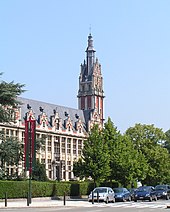
There are severaluniversitiesin Brussels. Except for theRoyal Military Academy,a federal military college established in 1834,[281]all universities in Brussels are private and autonomous. The Royal Military Academy also the only Belgian university organised on theboarding schoolmodel.[282]
TheUniversité libre de Bruxelles(ULB), a French-speaking university, with about 20,000 students, has three campuses in the city,[283]and theVrije Universiteit Brussel(VUB), itsDutch-speakingsister university, has about 10,000 students.[284]Both universities originate from a single ancestor university, founded in 1834, namely theFree University of Brussels,which was split in 1970, at about the same time the Flemish and French Communities gained legislative power over the organisation of higher education.[285]
Saint-Louis University, Brussels(also known as UCLouvain Saint-Louis – Bruxelles) was founded in 1858 and is specialised in social andhuman sciences,with 4,000 students, and located on two campuses in theCity of BrusselsandIxelles.[286]From September 2018 on, the university uses the nameUCLouvain,together with theCatholic University of Louvain,in the context of a merger between both universities.[287]
Still other universities have campuses in Brussels, such as the French-speaking Catholic University of Louvain (UCLouvain), which has 10,000 students in the city with its medical faculties atUCLouvain Bruxelles Woluwesince 1973,[288]in addition to itsFaculty of Architecture, Architectural Engineering and Urban Planning[289]and UCLouvain's Dutch-speaking sisterKatholieke Universiteit Leuven(KU Leuven)[290](offering bachelor's and master's degrees in economics & business, law, arts, and architecture; 4,400 students). In addition, the University of Kent'sBrussels School of International Studiesis a specialised postgraduate school offering advanced international studies.
Also a dozen of university colleges are located in Brussels, including two drama schools, founded in 1832: the French-speakingConservatoire Royaland itsDutch-speakingequivalent, theKoninklijk Conservatorium.[291][292]
Primary and secondary education
[edit]Most of Brussels pupils between the ages of 3 and 18 go to schools organised by theFrench-speaking Communityor theFlemish Community,with close to 80% going to French-speaking schools, and roughly 20% to Dutch-speaking schools. Due to the post-war international presence in the city, there are also a number of international schools, including theInternational School of Brussels,with 1,450 pupils, between the ages of2+1⁄2and 18,[293]theBritish School of Brussels,and the fourEuropean Schools,which provide free education for the children of those working in theEU institutions.The combined student population of the fourEuropean Schoolsin Brussels is around 10,000.[294]
Libraries
[edit]
Brussels has a number of public or private-ownedlibrarieson its territory.[295]Most public libraries in Brussels fall under the competence of the Communities and are usually separated between French-speaking and Dutch-speaking institutions, although some are mixed.[verification needed]
TheRoyal Library of Belgium(KBR) is thenational libraryof Belgium and one of the most prestigious libraries in the world. It owns several collections of historical importance, like the famousFétisarchives, and is the depository for all books ever published in Belgium or abroad by Belgian authors. It is located on theMont des Arts/Kunstbergin central Brussels, near theCentral Station.[296]
There are several academic libraries and archives in Brussels. The libraries of theUniversité libre de Bruxelles(ULB) and theVrije Universiteit Brussel(VUB) constitute the largest ensemble of university libraries in the city. In addition to theSolboschlocation, there are branches inLa PlaineandErasme/Erasmus.[297][298]Other academic libraries include those ofSaint-Louis University, Brussels[299]and theCatholic University of Louvain(UCLouvain).[300]
Science and technology
[edit]
Science and technology in Brussels is well developed with the presence of severaluniversitiesand research institutes. The Brussels-Capital Region is home to several national science and technology institutes including theNational Fund for Scientific Research(NFSR), theInstitute for the Encouragement of Scientific Research and Innovation of Brussels(ISRIB), theRoyal Academies for Science and the Arts of Belgium(RASAB) and theBelgian Academy Council of Applied Sciences(BACAS). Several science parks associated with the universities are also spread over the region.
TheRoyal Belgian Institute of Natural Sciences,located inLeopold Park,houses the world's largest hall completely dedicated todinosaurs,with its collection of 30fossilisedIguanodonskeletons.[301]In addition, thePlanetariumof theRoyal Observatory of Belgium(part of the institutions of theBelgian Federal Science Policy Office), on theHeysel PlateauinLaeken,is one of the largest in Europe.[302]
Healthcare
[edit]
Brussels is home to a thrivingpharmaceuticalandhealth careindustry which includes pioneeringbiotechnologyresearch. The health sector employs 70,000 employees in 30,000 companies. There are 3,000 life sciences researchers in the city and two largescience parks:Da Vinci Research Park and Erasmus Research Park. There are fiveuniversity hospitals,amilitary hospitaland more than 40 general hospitals and specialist clinics.[303]
Due toits bilingual nature,hospitals in the Brussels-Capital Region can be either monolingual French, monolingual Dutch, or bilingual, depending on their nature. University hospitals belong to one of the twolinguistic communitiesand are thus monolingual French or Dutch by law. Other hospitals managed by a public authority must be legally bilingual. Private hospitals are legally not bound to either language, but most cater to both. However, all hospital emergency services in the Capital Region (whether part of a public or private hospital) are required to be bilingual, since patients transported by emergencyambulancecannot choose the hospital they will be brought to.[304]
Transport
[edit]Brussels has an extensive network of both private or public transportation means. Public transportation includesBrussels buses,trams,andmetro(all three operated by theBrussels Intercommunal Transport Company(STIB/MIVB)), as well as a set of railway lines (operated byInfrabel) and railway stations served by public trains (operated by theNational Railway Company of Belgium(NMBS/SNCB)). Air transport is available via one of the city's two airports (Brussels AirportandBrussels South Charleroi Airport), and boat transport is available via thePort of Brussels.Bicycle-sharing and car-sharing public systems are also available.
The complexity of the Belgian political landscape makes some transportation issues difficult to solve. The Brussels-Capital Region is surrounded by theFlemishandWalloonregions, which means that the airports, as well as many roads serving Brussels (most notably theBrussels Ring) are located in the other two Belgian regions. The city is relatively car-dependent by northern European standards and is considered to be the most congested city in the world according to theINRIXtraffic survey.[305]
Air
[edit]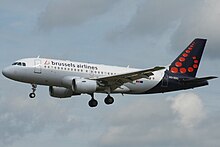
The Brussels-Capital Region is served by two airports, both located outside of the administrative territory of the region. The most notable isBrussels Airport,located in the nearby Flemish municipality ofZaventem,12 km (10 mi) east of the capital, which can be accessed by highway (A201), train and bus. The secondary airport isBrussels South Charleroi Airport,located inGosselies,a part of the city ofCharleroi(Wallonia), some 50 km (30 mi) south-west of Brussels, which can be accessed by highway (E19 then E420) or a private bus. There is alsoMelsbroek Air Base,located inSteenokkerzeel,a military airport which shares its infrastructure with Brussels Airport. The aforementioned airports are also the main airports of Belgium.[306]
Water
[edit]
Since the 16th century, Brussels has had its own harbour, thePort of Brussels.It has been enlarged throughout the centuries to become the second Belgian inland port. Historically situated near thePlace Sainte-Catherine/Sint-Katelijneplein,it lies today to the north-west of the region, on theBrussels–Scheldt Maritime Canal(commonly called Willebroek Canal), which connects Brussels toAntwerpvia theScheldt.Ships and large barges up to 4,500 t (9,900,000 lb) can penetrate deep into the country, avoiding break-ups and load transfers between Antwerp and the centre of Brussels, hence reducing the cost for companies using the canal, and thus offering a competitive advantage.
Moreover, the connection of the Willebroek Canal with theBrussels–Charleroi Canal,in the very heart of the capital, creates a north–south link, by means of waterways, between the Netherlands, Flanders and the industrial zone ofHainaut(Wallonia). There, navigation can access the network of French canals, thanks to the importantinclined planeofRonquièresand the lifts ofStrépy-Bracquegnies.
The importance of river traffic in Brussels makes it possible to avoid the road equivalent of 740,000 trucks per year—almost 2,000 per day—which, in addition to easing traffic problems, represents an estimated carbon dioxide saving of 51,545 t (113,637,000 lb) per year.[307]
Train
[edit]
The Brussels-Capital Region has three main train stations:Brussels-South,Brussels-CentralandBrussels-North,which are also the busiest of the country.[42]Brussels-South is also served by direct high-speed rail links: toLondonbyEurostartrains via theChannel Tunnel(1hr 51min); toAmsterdam[308]byThalysandInterCityconnections; to Amsterdam,Paris(1hr 50min and 1hr 25min respectively as of 6 April 2015[update]), andColognebyThalys;and to Cologne (1hr 50min) andFrankfurt(2hr 57min) by the GermanICE.
The train rails in Brussels go underground, near the centre, through theNorth–South connection,with Brussels Central Station also being largely underground. The tunnel itself is only six tracks wide at its narrowest point, which often causes congestion and delays due to heavy use of the route.
TheCity of Brusselshas minor railway stations atBockstael,Brussels-Chapel,Brussels-Congress,Brussels-Luxembourg,Brussels-Schuman,Brussels-West,Haren,Haren-SouthandSimonis.In the Brussels Region, there are also railways stations atBerchem-Sainte-Agathe,Boitsfort,Boondael,Bordet (Evere),Etterbeek,Evere,Forest-East,Forest-South,Jette,Meiser (Schaerbeek),Moensberg (Uccle),Saint-Job (Uccle),Schaarbeek,Uccle-Calevoet,Uccle-Stalle,Vivier d'Oie-Diesdelle (Uccle),MerodeandWatermael.
Public transport
[edit]TheBrussels Intercommunal Transport Company(STIB/MIVB) is the localpublic transportoperator in Brussels. It covers the 19 municipalities of the Brussels-Capital Region and some surface routes extend to the near suburbs in the other two regions, linking with theDe Lijnnetwork inFlandersand theTECnetwork inWallonia.
Metro, trams and buses
[edit]
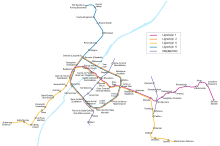
TheBrussels Metrodates back to 1976,[309]but underground lines known as thepremetrohave been serviced by tramways since 1968. It is the onlyrapid transitsystem in Belgium (AntwerpandCharleroiboth havinglight railsystems). The network consists of four conventional metro lines and threepremetrolines. The metro-grade lines areM1,M2,M5,andM6,with some shared sections, covering a total of 40 km (25 mi).[310]As of 2017[update],the Metro network within the region has a total of69 metro andpremetrostations.The Metro is an importantmeans of transport,connecting with sixrailway stationsof theNational Railway Company of Belgium(NMBS/SNCB), and many tram and bus stops operated by STIB/MIVB, as well as withFlemishDe LijnandWalloonTECbus stops.
A comprehensivebusandtram networkcovers the region. As of 2017[update],the Brussels tram system consists of 17 tram lines (three of which – linesT4,T7and T10 – qualify aspremetrolines that partly travel over underground sections that were intended to be eventually converted into metro lines).[311]The total route length is 139 km (86 mi),[310]making it one of the largest tram networks in Europe. The Brussels bus network is complementary to the rail network. It consists of 50 bus routes and 11 night routes, spanning 445 km (277 mi).[310]
Since April 2007, STIB/MIVB has also been operating a night bus network called Noctis on Friday and Saturday nights from midnight until 3 a.m.[312]The service consists of 11 routes (N04, N05, N06, N08, N09, N10, N11, N12, N13, N16 and N18).[313]The fare on these night buses is the same as during the day. All the lines leave from thePlace de la Bourse/Beurspleinin the city centre at 30 minutes intervals and cover all the main streets in the capital, as they radiate outwards to the suburbs.[314]Noctis services returned from 2 July 2021 after over a year of disruption due to theCOVID-19 pandemic in Belgium.[312]
Ticketing
[edit]MoBIB is the STIB/MIVB electronic smart card, introduced in 2007, replacing the discontinued paper tickets. The hourly travel fare includes all means of transport (metro, tram and bus) operated by STIB/MIVB. Each trip has a different cost depending on the type of support purchased. Passengers can purchase monthly passes, yearly passes, 1 and 10-trip tickets and daily and 3-day passes. These can be bought over the Internet, but require customers to have a smart card reader. GO vending machines accept coins, local and international chip and PIN credit and debit cards.
Moreover, a complimentary interticketing system means that a combined STIB/MIVB ticket holder can, depending on the option, also use the train network operated by NMBS/SNCB and/or long-distance buses and commuter services operated by De Lijn or TEC. With this ticket, a single journey can include multiple stages across the different modes of transport and networks.
Other public transport
[edit]
Since 2003, Brussels has had a car-sharing service operated by theBremencompany Cambio, in partnership with STIB/MIVB and the local ridesharing company Taxi Stop.[315]In 2006, apublic bicycle-sharing programmewas introduced. The scheme was subsequently taken over byVillo!.Since 2008, this night-time public transport service has been supplemented by Collecto, a shared taxi system, which operates on weekdays between 11 p.m. and 6 a.m.[316]In 2012, the Zen Car electric car-sharing scheme was launched in the university and European areas, though it ceased operating in the city in 2020.[317]
Road network
[edit]
In medieval times, Brussels stood at the intersection of routes running north–south (the modernRue Haute/Hoogstraat) and east–west (Chaussée de Gand/Gentsesteenweg–Rue du Marché aux Herbes/Grasmarkt–Rue de Namur/Naamsestraat). The ancient pattern of streets, radiating from theGrand-Place,in large part remains, but has been overlaid by boulevards builtover the river Senne,over the city wallsand over the railway connection between the North and South Stations. Nowadays, Brussels has the most congested traffic in North America and Europe, according to US traffic information platformINRIX.[318]
Brussels is the hub of a range of national roads, the main ones being clockwise: theN1(N toBreda),N2(E toMaastricht),N3(E toAachen),N4(SE toLuxembourg),N5(S toReims), N6 (S toMaubeuge), N7 (SW toLille),N8(W toKoksijde) and N9 (NW toOstend).[319]Usually namedchaussées/steenwegen,these highways normally run in a straight line, but sometimes lose themselves in a maze of narrow shopping streets. The region is skirted by theEuropean route E19(N-S) and theE40(E-W), while theE411leads away to the SE. Brussels has anorbital motorway,numbered R0 (R-zero) and commonly referred to as theRing.It is pear-shaped, as the southern side was never built as originally conceived, owing to residents' objections.
The city centre, sometimes known as thePentagon,is surrounded by an inner ring road, theSmall Ring(French:Petite Ceinture,Dutch:Kleine Ring), a sequence of boulevards formally numbered R20 or N0. These were built upon the site of thesecond set of city wallsfollowing their demolition. TheMetro line 2runs under much of these. Since June 2015, a number ofcentral boulevardsinside the Pentagon have become car-free, limiting transit traffic through the old city.[320]
On the eastern side of the region, the R21 orGreater Ring(French:Grande Ceinture,Dutch:Grote Ring) is formed by a string of boulevards that curves round fromLaekentoUccle.Somepremetrostations (seeBrussels Metro) were built on that route. A little further out, a stretch numbered R22 leads from Zaventem toSaint-Job.
Security and emergency services
[edit]Police
[edit]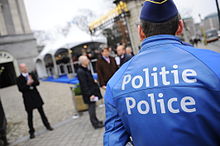
The Brussels localpolice,supported by the federal police, is responsible for law enforcement in Brussels. The 19 municipalities of the Brussels-Capital Region are divided into six police zones,[321]all bilingual (French and Dutch):
- 5339 Brussels Capital Ixelles: theCity of BrusselsandIxelles
- 5340 Brussels West:Berchem-Sainte-Agathe,Ganshoren,Jette,KoekelbergandMolenbeek-Saint-Jean
- 5341 South:Anderlecht,ForestandSaint-Gilles
- 5342 Uccle/Watermael-Boitsfort/Auderghem:Auderghem,UccleandWatermael-Boitsfort
- 5343 Montgomery:Etterbeek,Woluwe-Saint-LambertandWoluwe-Saint-Pierre
- 5344 Polbruno:Evere,Saint-Josse-ten-NoodeandSchaerbeek
Fire department
[edit]The Brussels Fire and Emergency Medical Care Service, commonly known by its acronym SIAMU (DBDMH), operates in the 19 municipalities of Brussels.[322]It is a class X fire department and the largestfire servicein Belgium in terms of annual operations, equipment, and personnel. It has 9fire stations,spread over the entire Brussels-Capital Region, and employs about 1,000 professionalfirefighters.As well as preventing and fighting fires, SIAMU also provides emergency medical care services in Brussels via its centralised 100 number (and the single 112 emergency number for the 27 countries of the European Union). It is bilingual (French–Dutch).
Parks and green spaces
[edit]Brussels is one of the greenest capitals in Europe, with over 8,000 hectares of green spaces.[323]Vegetation cover and natural areas are higher in the outskirts, where they have limited theperi-urbanisationof the capital, but they decrease sharply towards the centre of Brussels; 10% in the centralPentagon,30% of the municipalities in the first ring, and 71% of the municipalities in the second ring are occupied by green spaces.
Many parks and gardens, both public and privately owned, are scattered throughout the city. In addition to this, theSonian Forestis located in its southern part and stretches out over the threeBelgian regions.As of 2017[update],it has been inscribed as aUNESCOWorld Heritage Site,the only Belgian component to the multinational inscription 'Primeval Beech Forests of the Carpathians and Other Regions of Europe'.[324]
Notable people
[edit]Twin towns – sister cities
[edit]Brussels istwinnedwith the following cities:[325]
See also
[edit]- Bourgeois of Brussels
- Nazi ghost train
- Seven Noble Houses of Brussels
- Sculpture in Brussels
- Brussels Regional Investment Company
- European Network of Information Centres for the Performing Arts
- List of urban areas in the European Union
References
[edit]Footnotes
[edit]- ^French pronunciation:[ʁeʒjɔ̃dəbʁy(k)sɛlkapital].
- ^Dutch pronunciation:[ˈbrʏsəlsˌɦoːftˈsteːdələkxəˈʋɛst].Gewestin isolation ispronounced[ɣəˈʋɛst].
- ^Brussels is notformally declaredcapital of the EU, though its position is spelled out in theTreaty of Amsterdam.Seethe section dedicated to this issue.
- ^The six municipalities with language facilities around Brussels areWemmel,Kraainem,Wezembeek-Oppem,Sint-Genesius-Rode,LinkebeekandDrogenbos.
Citations
[edit]- ^abcdDemey 2007.
- ^ab"How Brussels became the capital of Europe 500 years ago".The Brussels Times.21 April 2017.Archivedfrom the original on 14 July 2019.Retrieved13 August2019.
- ^abcHerbez, Ariel (30 May 2009)."Bruxelles, capitale de la BD".Le Temps(in French). Switzerland.Retrieved28 May2010.
Plus que jamais, Bruxelles mérite son statut de capitale de la bande dessinée.
[dead link] - ^"be.STAT".bestat.statbel.fgov.be.Archivedfrom the original on 24 September 2024.Retrieved31 July2024.
- ^"Mini-Bru | IBSA".ibsa.brussels.Archivedfrom the original on 9 March 2021.Retrieved17 March2021.
- ^"Structuur van de bevolking | Statbel".Statbel.fgov.be(in Dutch).Archivedfrom the original on 14 February 2021.Retrieved11 January2020.
- ^abMichèle Tribalat,Population d'origine étrangère en Belgique en 2020Archived2 May 2021 at theWayback Machine,8 February 2021
- ^"EU regions by GDP, Eurostat".Archivedfrom the original on 27 February 2023.Retrieved18 September2023.
- ^"Gross domestic product (GDP) at current market prices by metropolitan regions".ec.europa.eu.Archivedfrom the original on 15 February 2023.Retrieved20 February2024.
- ^"Gross domestic product (GDP) at current market prices by metropolitan regions".ec.europa.eu.Archivedfrom the original on 15 February 2023.
- ^"Sub-national HDI – Area Database – Global Data Lab".hdi.globaldatalab.org.Archivedfrom the original on 23 September 2018.Retrieved18 August2019.
- ^abThe Belgian Constitution(PDF).Brussels: Belgian House of Representatives. May 2014. p. 5. Archived fromthe original(PDF)on 10 August 2015.Retrieved10 September2015.
Article 3:Belgiumcomprises three Regions: the Flemish Region, the Walloon Region and the Brussels Region. Article 4: Belgium comprises four linguistic regions: the Dutch-speaking region, the French-speaking region, the bilingual region of Brussels-Capital and the German-speaking region.
- ^ab"Brussels-Capital Region / Creation".Centre d'Informatique pour la Région Bruxelloise [Brussels Regional Informatics Center]. 2009. Archived fromthe originalon 29 April 2009.Retrieved5 June2009.
Since 18 June 1989, the date of the first regional elections, the Brussels-Capital Region has been an autonomous region comparable to the Flemish and Walloon Regions.
(All text and all but one graphic show the English name as Brussels-Capital Region.) - ^abThe Belgian Constitution(PDF).Brussels, Belgium: Belgian House of Representatives. May 2014. p. 63. Archived fromthe original(PDF)on 10 August 2015.Retrieved10 September2015.
Article 194: The city of Brussels is the capital of Belgium and the seat of the Federal Government.
- ^abDécret instituant Bruxelles capitale de la Communauté française.Brussels, Belgium: Parliament of the French Community. 4 April 1984. Archived fromthe originalon 15 October 2015.Retrieved11 September2015.
- ^"The Flemish Community".Belgium.be.24 October 2011.Archivedfrom the original on 1 April 2018.Retrieved1 April2018.
- ^abDecreet betreffende de keuze van Brussel tot hoofdstad van de Vlaamse Gemeenschap(PDF).Brussels, Belgium: Flemish Parliament. 6 March 1984. Archived fromthe original(PDF)on 7 March 2021.Retrieved11 September2015.
- ^"DE BELGISCHE GRONDWET".senate.be.Archivedfrom the original on 5 October 2018.Retrieved24 October2017.
- ^Schaepdrijver, Sophie de (1990).Elites for the Capital?: Foreign Migration to mid-nineteenth-century Brussels.Amsterdam: Thesis Publishers.ISBN9789051700688.
- ^Hughes, Dominic (15 July 2008)."Europe | Analysis: Where now for Belgium?".BBC News.Archivedfrom the original on 19 July 2008.Retrieved29 June2010.
- ^Philippe Van Parijs (1 March 2016)."Brussels bilingual? Brussels francophone? Both and neither!".The Brussels Times.Archived fromthe originalon 2 May 2019.
- ^abcJanssens, Rudi (2008).Language use in Brussels and the position of Dutch. Some recent findings(PDF).Brussels Studies. Archived fromthe original(PDF)on 23 September 2015.Retrieved24 November2018.
- ^abO'Donnell, Paul; Toebosch, AnneMarie.Multilingualism in Brussels: "I'd Rather Speak English".Journal of Multilingual and Multicultural Development, 2008, v. 29 n. 2 p. 154-169.
- ^"Europe | Country profiles | Country profile: Belgium".BBC News. 14 June 2010.Archivedfrom the original on 1 July 2010.Retrieved29 June2010.
- ^"Protocol (No 6) on the location of the seats of the institutions and of certain bodies, offices, agencies and departments of the European Union, Consolidated version of the Treaty on the Functioning of the European Union, OJ C 83, 30.3.2010, p. 265–265".EUR-Lex. 30 March 2010.Archivedfrom the original on 8 July 2012.Retrieved3 August2010.
- ^"Spain to ask Brussels for extra year to meet deficit target".Reuters.10 April 2016. Archived fromthe originalon 29 July 2020.Retrieved23 June2017.
- ^Rankin, Jennifer (13 June 2017)."Brussels plan could force euro clearing out of UK after Brexit".The Guardian.ISSN0261-3077.Archivedfrom the original on 31 December 2021.Retrieved23 June2017.
- ^"Secrétariat general".A propos du Benelux(in French).Archivedfrom the original on 14 December 2021.Retrieved22 August2017.
- ^"NATO Headquarters".NATO.16 March 2018.Archivedfrom the original on 18 December 2021.Retrieved22 August2017.
- ^ab"Gross domestic product per resident, at current prices – Ratio in relation to the total of the Kingdom".National Bank of Belgium.Archived fromthe originalon 8 August 2014.Retrieved20 April2014.
- ^Average income in Belgium reached 19,105 euros in 2019.Belgian Federal Government. 26 October 2021.Archivedfrom the original on 3 October 2022.Retrieved3 October2022.
- ^ab"Structuur van de bevolking | Statbel".statbel.fgov.be.Archivedfrom the original on 14 February 2021.Retrieved13 August2020.
- ^"Statistics Belgium;Population de droit par commune au 1 janvier 2008".Archived fromthe original(excel-file)on 17 September 2008.Retrieved17 September2008.Population of all municipalities in Belgium on 1 January 2008. Retrieved on 18 October 2008.
- ^ab"Statistics Belgium;De Belgische Stadsgewesten 2001"(PDF).Archived fromthe original(PDF)on 29 October 2008.Retrieved19 October2008.Definitions of metropolitan areas in Belgium. The metropolitan area of Brussels is divided into three levels. First, the central agglomeration (geoperationaliseerde agglomeratie) with 1,451,047 inhabitants (2008-01-01, adjusted to municipal borders). Adding the closest surroundings (suburbs,banlieueorbuitenwijken) gives a total of 1,831,496. And, including the outer commuter zone (forensenwoonzone) the population is 2,676,701.
- ^ab"Demographia World Urban Areas"(PDF).April 2017.Archived(PDF)from the original on 17 May 2017.Retrieved29 October2017.
- ^abVan Meeteren et al. 2016.
- ^"The World According to GaWC 2016".GaWC.24 April 2017.Archivedfrom the original on 10 October 2013.Retrieved22 August2017.
- ^"Transportation in Brussels".internations.org.Archivedfrom the original on 4 August 2018.Retrieved3 August2018.
- ^"Brussels Capital Region".coe.int.Archivedfrom the original on 19 December 2021.Retrieved19 December2021.
- ^NATO."Belgium and NATO – 1949".NATO.Archivedfrom the original on 19 December 2021.Retrieved19 December2021.
- ^"Musée Fin-de-Siècle Museum – brusselscard".visit.brussels.Archivedfrom the original on 19 December 2021.Retrieved19 December2021.
- ^ab"The Brussels Times – Brussels North is Belgium's busiest train station".Archived fromthe originalon 2 May 2019.Retrieved3 August2018.
- ^"Statistics".Brussels Airport Website.Archived fromthe originalon 18 March 2011.Retrieved3 August2018.
- ^"Gastronomy — Région bruxelloise – Brussels Gewest".be.brussels.Archivedfrom the original on 3 August 2018.Retrieved3 August2018.
- ^"UNESCO heritage in Brussels".Archivedfrom the original on 3 August 2018.Retrieved3 August2018.
- ^ab"The walls of the comic strip walk in detail".Archivedfrom the original on 3 August 2018.Retrieved3 August2018.
- ^Geert van IstendaelArm Brussel,uitgeverij Atlas,ISBN90-450-0853-X
- ^(in Dutch)Zo ontstond BrusselArchived2011-07-06 at theWayback MachineVlaamse Gemeenschapscommissie – Commission of the Flemish Community in Brussels
- ^Jean Baptiste D'Hane; François Huet; P.A. Lenz; H.G. Moke (1837).Nouvelles archives historiques, philosophiques, et littéraires(in French). Vol. 1. Gent: C. Annoot- Braeckman. p. 405.Archivedfrom the original on 19 August 2021.Retrieved3 May2018.
- ^Tribot & Defawe 2006,p. 3.
- ^abcdTreffers-Daller 1994,p. 25.
- ^abMary Anne Evans,Frommer's Brussels and Bruges Day by Day. First Edition(Hoboken: John Wiley & Sons, 2008), 71.
- ^Jean d'Osta,Dictionnaire historique des faubourgs de Bruxelles,édition Le LivreISBN978-2-930135-10-6.
- ^abAlain Lerond,Dictionnaire de la prononciation(1980), Larousse, pp. 477.
- ^"Bruxelles: des vestiges romains retrouvés sur le site de Tour et Taxis".RTBF Info(in French). 6 August 2015.Archivedfrom the original on 23 August 2017.Retrieved28 April2017.
- ^"Les Romains de Tour & Taxis — Patrimoine – Erfgoed".patrimoine.brussels(in French).Archivedfrom the original on 10 April 2017.Retrieved28 April2017.
- ^State 2004,p. 269.
- ^Riché 1983,p. 276.
- ^"Zo ontstond Brussel"[This is how Brussels originated] (in Dutch). Vlaamse Gemeenschapscommissie [Commission of the Flemish Community in Brussels]. Archived fromthe originalon 20 November 2007.
- ^Brigode 1938,p. 185–215.
- ^Blockmans & Prevenier 1999,p. 30–31.
- ^Kirk 1868,p. 542.
- ^Armstrong 1957,p. 228.
- ^Jenkins, Everett Jr. (7 May 2015).The Muslim Diaspora (Volume 2, 1500–1799): A Comprehensive Chronology of the Spread of Islam in Asia, Africa, Europe and the Americas.McFarland.ISBN9781476608891.Archivedfrom the original on 14 April 2021.Retrieved13 August2019– via Google Books.
- ^Wasseige 1995,p. 4.
- ^Mardaga 1994,p. 222.
- ^Wasseige 1995,p. 6–7.
- ^Souchal, Geneviève (ed.),Masterpieces of Tapestry from the Fourteenth to the Sixteenth Century: An Exhibition at the Metropolitan Museum of Art,p. 108, 1974, Metropolitan Museum of Art (New York, N.Y.), Galeries nationales du Grand Palais (France),ISBN0870990861,9780870990861,google booksArchived29 October 2021 at theWayback Machine
- ^Campbell, ed.Tapestry in the Renaissance: Art and Magnificence,exhibition catalogue,Metropolitan Museum of Art2002.
- ^Culot et al. 1992.
- ^Tucker 2009,p. 753.
- ^Oudiette 1804,p. XIII.
- ^Duvergier 1835,p. 300.
- ^Galloy & Hayt 2006,p. 86–90.
- ^Slatin 1979,p. 53–54.
- ^Pirenne 1948,p. 30.
- ^Charruadas 2005.
- ^Wolmar 2010,p. 18–20.
- ^Demey 1990,p. 65.
- ^Eggericx 1997,p. 5.
- ^abSchroeder-Gudehus & Rasmussen 1992.
- ^Culot & Pirlot 2005.
- ^ab"Major Town Houses of the Architect Victor Horta (Brussels)".whc.unesco.org.UNESCO World Heritage Centre.Archivedfrom the original on 13 May 2013.Retrieved14 February2017.
- ^"STIB – La STIB de 1960 à 1969"[STIB – STIB from 1960 to 1969] (in French). STIB. 2013. Archived fromthe originalon 21 December 2013.Retrieved15 September2013.
- ^"STIB – Historique de la STIB de 1970 à 1979"[STIB – History of STIB from 1970 to 1979] (in French). STIB. 2013. Archived fromthe originalon 21 October 2013.Retrieved15 September2013.
- ^abState 2004,p. 51–52.
- ^abStubbs & Makaš 2011,p. 121.
- ^"The Brussels-Capital Region".Belgium.be.1 February 2012.Archivedfrom the original on 24 November 2018.Retrieved24 November2018.
- ^"LOI – WET".ejustice.just.fgov.be(in French).Archivedfrom the original on 1 March 2021.Retrieved22 April2017.
- ^"Association of European Cities of Culture of the Year 2000".Krakow the Open City.17 August 2011.Archivedfrom the original on 7 January 2017.Retrieved24 February2017.
- ^srbija.gov.rs."Brussels Agreement".srbija.gov.rs.Archivedfrom the original on 15 July 2021.Retrieved15 July2021.
- ^ab"Brussels G7 summit, Brussels, 04-05/06/2014 – Consilium".European Council.Archivedfrom the original on 7 February 2017.Retrieved6 February2017.
- ^"NATO Summit 2017".state.gov.Archived fromthe originalon 25 May 2017.Retrieved27 July2017.
- ^"NATO Secretary General announces dates for 2018 Brussels Summit".nato.int.20 October 2017.Archivedfrom the original on 11 May 2019.Retrieved13 October2021.
- ^ab"NATO Secretary General announces date of the 2021 Brussels Summit".nato.int.22 April 2021.Archivedfrom the original on 29 April 2021.Retrieved29 April2021.
- ^Dearden, Lizzie (22 March 2016)."Brussels attacks timeline: How bombings unfolded at airport and Metro station".The Independent.Archivedfrom the original on 1 May 2022.Retrieved22 March2016.
- ^"Brussels explosions: What we know about airport and metro attacks".BBC News. 9 April 2016.Archivedfrom the original on 2 June 2018.Retrieved21 June2018.
- ^"Victims of the Brussels attacks".BBC News. 15 April 2016.Archivedfrom the original on 12 March 2023.Retrieved12 March2023.
- ^"Brussels attacks: 'Let us dare to be tender,' says king on first anniversary".The Guardian.22 March 2017.Archivedfrom the original on 10 March 2023.Retrieved10 March2023.
- ^"Brussels in figures 1".visit.brussels.Archivedfrom the original on 3 September 2017.Retrieved3 September2017.
- ^"Le point le plus haut de la région Bruxelloise se trouve en forêt de Soignes".RTBF Info(in French). 22 May 2019.Archivedfrom the original on 14 April 2021.Retrieved10 February2021.
- ^"Brussels, Belgium Köppen Climate Classification (Weatherbase)".Weatherbase.Archivedfrom the original on 27 July 2020.Retrieved2 July2019.
- ^"Normales climatiques à Uccle"(in French). Royal Meteorological Institute. Archived fromthe originalon 3 February 2021.Retrieved5 March2021.
- ^"Le climat de la Belgique"(in French). Royal Meteorological Institute. Archived fromthe originalon 14 April 2021.Retrieved5 March2021.
- ^"Brussels, Belgium – Detailed climate information and monthly weather forecast".Weather Atlas.Yu Media Group.Archivedfrom the original on 2 July 2019.Retrieved2 July2019.
- ^Kristien Bonneure; Johan Droessaert; Gianni Paelinck; Denny Baert (25 July 2019)."Herlees onze Hitteblog: warmste dag ooit eindigt met chaos door propvolle treinen die terugkeren van de kust".VRT Nieuws.Archivedfrom the original on 3 September 2019.Retrieved26 July2019.
- ^"Palais Royal – Inventaire du patrimoine architectural".monument.heritage.brussels(in French).Retrieved23 October2024.
- ^"Le Château royal de Laeken – Inventaire du patrimoine architectural".monument.heritage.brussels(in French).Retrieved23 October2024.
- ^"Palais de la Nation – Inventaire du patrimoine architectural".monument.heritage.brussels(in French).Retrieved23 October2024.
- ^"Brussels, the capital of Flanders".Flemish Department of Foreign Affairs. Archived fromthe originalon 10 June 2011.Retrieved6 November2009.
- ^"Brussels-Capital region / Communes".Brussels Capital-Region / Région de Bruxelles-Capitale.Archived fromthe originalon 6 June 2004.Retrieved4 August2008.
- ^ab"Managing across levels of government"(PDF).OECD. 1997. pp. 107, 110. Archived fromthe original(PDF)on 19 August 2008.Retrieved5 August2008.
- ^abPicavet, Georges (29 April 2003)."Municipalities (1795-now)".Georges Picavet.Archivedfrom the original on 17 August 2011.Retrieved4 August2008.
- ^"Brussels Capital-Region".Georges Picavet. 4 June 2005.Archivedfrom the original on 25 July 2011.Retrieved4 August2008.
- ^"Fusie van de 19 Brusselse gemeenten".Archivedfrom the original on 20 August 2015.Retrieved26 August2015.
- ^"De Brusselse Baronieën".Archived fromthe originalon 3 September 2015.Retrieved26 August2015.
- ^"Bruxelles vaut bien une messe?"(PDF).Archived fromthe original(PDF)on 12 August 2014.Retrieved7 August2014.
- ^Levitt, Matthew (27 March 2016)."My Journey To Brussels' Terrorist Safe Haven".Politico.
- ^"Brussels attacks: Molenbeek's gangster jihadists".BBC. 24 March 2016.Archivedfrom the original on 9 April 2016.Retrieved13 April2016.
- ^"The Belgian neighborhood indelibly linked to jihad".The Washington Post.15 November 2015.Archivedfrom the original on 8 April 2016.Retrieved13 April2016.
- ^"Beleaguered Molenbeek struggles to fend off jihadist recruiters".The Times of Israel.3 April 2016.Archivedfrom the original on 7 April 2016.Retrieved13 April2016.
- ^"World points to" jihad Capital "Molenbeek".Het Nieuwsblad.16 November 2015.Archivedfrom the original on 26 April 2016.Retrieved13 April2016.
- ^"Wet houdende organisatie van de agglomeraties en de federaties van gemeenten".Belgiëlex.be.FOD Justitie.Archivedfrom the original on 4 March 2016.Retrieved11 September2015.
- ^Procedure contained in art. 138 of the Belgian Constitution
- ^Procedure in art. 137 of the Belgian Constitution
- ^ab"Seat of the European Commission".European Navigator.Archivedfrom the original on 30 September 2007.Retrieved15 June2022.
- ^abEuropean Commission publication:Europe in Brussels2007
- ^Wheatley, Paul (2 October 2006)."The two-seat parliament farce must end".cafébabel.Archived fromthe originalon 10 June 2007.Retrieved16 July2007.
- ^Stark, Christine (2 September 2002).Evolution of the European Council: The implications of a permanent seat(PDF).The UACES Thirty-second Annual Conference and Seventh Research Conference, 2–4 September 2002. Archived fromthe original(PDF)on 9 July 2007.Retrieved12 July2007.
- ^Vucheva, Elitsa (5 September 2007)."EU quarter in Brussels set to grow".eubserver.Archivedfrom the original on 6 December 2012.Retrieved27 September2007.
- ^abParker, John (January–February 2007). "A tale of two cities".E!Sharp.
- ^"Brussels, an international city and European capital".L'université Libre de Bruxelles.Archived fromthe originalon 3 August 2010.
- ^ab"Brussels: home to international organisations".diplomatie.be.Archived fromthe originalon 15 February 2006.
- ^Andrew Rettman (8 March 2010)."Daylight shooting in EU capital raises alarm".euobserver.Archivedfrom the original on 13 December 2013.Retrieved29 June2010.
- ^Leigh Phillips (11 March 2010)."Majority of Brussels lobby firms avoid registry".euobserver.Archivedfrom the original on 16 April 2010.Retrieved29 June2010.
- ^Software, A7."Accessibility".Wallonia.be.Archivedfrom the original on 23 May 2022.Retrieved16 June2022.
{{cite web}}:CS1 maint: numeric names: authors list (link) - ^"Recognised NGOs".diplomatie.23 March 2016.Archivedfrom the original on 18 May 2022.Retrieved16 June2022.
- ^"Brussels Pact".brussels.info.Archived fromthe originalon 5 February 2017.Retrieved4 February2017.
- ^NATO."Summit meetings".NATO.Archivedfrom the original on 8 September 2014.Retrieved2 March2017.
- ^Isby, David C.; Kamps, Charles Jr. (1985).Armies of NATO's Central Front.Jane's Information Group. p. 13.ISBN9780710603418.
- ^NATO."New NATO Headquarters".NATO.Archivedfrom the original on 5 August 2017.Retrieved8 January2017.
- ^McInally, John (December 2010)."Eurocontrol History Book"(PDF).Eurocontrol. Archived fromthe original(PDF)on 12 March 2016.
- ^"Très riches et très pauvres".Lalibre.be.Retrieved12 March2013.
- ^Meijers, Evert J. (2007).Synergy in Polycentric Urban Regions: Complementarity, Organising Capacity and Critical Mass.IOS Press. p. 54.ISBN9781586037246.Archivedfrom the original on 14 April 2021.Retrieved25 October2020.
- ^abcdefghi"Language selection – Statbel".statbel.fgov.be.Archivedfrom the original on 30 April 2009.Retrieved29 October2018.
- ^Population – Nationalités(Report) (in French). Brussels Institute for Statistics and Analysis. Tabel 1.3.1.4 – Principales nationalités actuelles: 2022 (au 1er janvier). Archived fromthe original(XLS)on 17 October 2023.Retrieved24 September2023.
- ^abDumont 1996,pp. 307–8, 312, 319.
- ^Historia,no. 680, August 2003, p. 36–37
- ^Buron 2016,p. 80–82.
- ^Van Parijs, Philippe."Belgium's new linguistic challenges"(PDF).KVS Express (Supplement to Newspaper de Morgen) March–April 2007:Article fromoriginal source (pdf 4.9 MB)pages 34–36 republished by the Belgian Federal Government Service (ministry) of Economy – Directorate–general Statistics Belgium. Archived fromthe original(pdf 0.7 MB)on 13 June 2007.Retrieved5 May2007.– The linguistic situation in Belgium (and in particular various estimations of the population speaking French and Dutch in Brussels) is discussed in detail."Hier ging iets mis | KVS"(PDF).Archived fromthe original(PDF)on 25 March 2009.Retrieved11 July2008.
- ^"Population et ménages"(PDF)(in French). IBSA Cellule statistique – Min. Région Bruxelles-Capitale (Statistical cell – Ministry of the Brussels-Capital Region).Retrieved5 May2007.[dead link]
- ^"2.738.486 inwoners van vreemde afkomst in België op 01/01/2012"[2,738,486 inhabitants of foreign origin in Belgium on 01/01/2012].Npdata.be(in Dutch).Archivedfrom the original on 22 October 2019.Retrieved12 March2013.
- ^abJanssens, Rudi (2013).BRIO-taalbarometer 3: diversiteit als norm[BRIO language barometer 3: diversity as standard](PDF)(in Dutch). Brussels Informatie-, Documentatie- en Onderzoekscentrum. Archived fromthe original(PDF)on 15 October 2018.Retrieved26 May2015.
- ^abcdBackhaus, Peter (2007).Linguistic Landscapes: A Comparative Study of Urban Multilingualism in Tokyo.Multilingual Matters Ltd. p. 158.ISBN9781853599460.Archivedfrom the original on 15 April 2021.Retrieved26 March2013.
- ^abcJaumain, Serge (2006).Vivre en Ville: Bruxelles et Montréal aux XIXe et XXe siècles(in French) (Études Canadiennes Series nº9 ed.). Peter Lang. p. 375.ISBN9789052013343.Archivedfrom the original on 28 January 2020.Retrieved26 April2013.
- ^abRoegiest, Eugeen (2009).Vers les sources des langues romanes. Un itinéraire linguistique à travers la Romania(in French). ACCO. p. 272.ISBN9789033473807.Archivedfrom the original on 28 January 2020.Retrieved26 April2013.
- ^abcJanssens, Guy (2005).Het Nederlands vroeger en nu(in Dutch). ACCO.ISBN9033457822.Archivedfrom the original on 14 April 2021.Retrieved26 April2013.
- ^Janssens, Rudi (2008).Taalgebruik in Brussel en de plaats van het Nederlands — Enkele recente bevindingen(PDF)(in Dutch) (Brussels Studies, nº13 ed.).Archived(PDF)from the original on 15 March 2016.Retrieved26 April2013.
- ^abcdKramer, Johannes (1984).Zweisprachigkeit in den Benelux-ländern.Buske Verlag.ISBN3871185973.Retrieved26 April2013.[permanent dead link]
- ^Baetens Beardsmore, Hugo (1986).Bilingualism: Basic Principles (2nd Ed.)(Multiligual Matters Series ed.). Multilingual Matters Ltd. p. 205.ISBN9780905028637.Archivedfrom the original on 28 January 2020.Retrieved26 April2013.
- ^Ernst, Gerhard (2006).Histoire des langues romanes(in French) (Manuel international sur l'histoire et l'étude linguistique des langues romanes ed.). Walter de Gruyter. p. 1166.ISBN9783110171501.Archivedfrom the original on 28 January 2020.Retrieved26 April2013.
- ^Vermeersch, Arthur J. (1981).De taalsituatie tijdens het Verenigd Koninkrijk der Nederlanden (1814–1830)(PDF)(in Dutch) (Taal en Sociale Integratie, IV ed.).Vrije Universiteit Brussel(VUB). pp. 389–404. Archived fromthe original(PDF)on 11 April 2016.Retrieved26 April2013.
- ^Poirier, Johanne (1999).Choix, statut et mission d'une capitale fédérale: Bruxelles au regard du droit comparé(in French) (Het statuut van Brussel / Bruxelles et son statut [61-97] ed.). Brussel: De Boeck & Larcier. p. 817.ISBN2-8044-0525-7.Archivedfrom the original on 14 April 2021.Retrieved11 February2021.
- ^Rousseaux, Xavier (1997).Le pénal dans tous ses états: justice, États et sociétés en Europe(in French) (Volume 74 ed.). Publications des Fac. St Louis. p. 462.ISBN9782802801153.Archivedfrom the original on 28 January 2020.Retrieved26 April2013.
- ^De Groof, Roel (2003).De kwestie Groot-Brussel en de politieke metropolisering van de hoofdstad (1830–1940). Een analyse van de besluitvorming en de politiek-institutionele aspecten van de voorstellen tot hereniging, annexatie, fusie, federatie en districtvorming van Brussel en zijn voorsteden(in Dutch) (De Brusselse negentien gemeenten en het Brussels model / Les dix-neuf communes bruxelloises et le modèle bruxellois [3-56] ed.). Brussel, Gent: De Boeck & Larcier. p. 754.ISBN2-8044-1216-4.Archivedfrom the original on 15 June 2022.Retrieved11 February2021.
- ^abcdGubin, Eliane(1978).La situation des langues à Bruxelles au 19ième siècle à la lumière d'un examen critique des statistiques(PDF)(in French) (Taal en Sociale Integratie, I ed.).Université Libre de Bruxelles.pp. 33–80. Archived fromthe original(PDF)on 11 April 2016.Retrieved26 April2013.
- ^abcWitte, Els (1998).Taal en politiek: De Belgische casus in een historisch perspectief(PDF)(in Dutch) (Balansreeks ed.). Brussel: VUBPress (Vrije Universiteit Brussel). p. 180.ISBN9789054871774.Archived(PDF)from the original on 26 May 2020.Retrieved15 June2022.
- ^Von Busekist, Astrid (2002).Nationalisme contre bilinguisme: le cas belge(in French) (La Politique de Babel: du monolinguisme d'État au plurilinguisme des peuples [191-226] ed.). Éditions KARTHALA. p. 348.ISBN9782845862401.Archivedfrom the original on 28 January 2020.Retrieved26 April2013.
- ^Bitsch, Marie-Thérèse (2004).Histoire de la Belgique: De l'Antiquité à nos jours(in French). Éditions Complexe. p. 299.ISBN9782804800239.Archivedfrom the original on 28 January 2020.Retrieved26 April2013.
- ^abTétart, Frank (2009).Nationalismes régionaux: Un défi pour l'Europe(in French). De Boeck Supérieur. p. 112.ISBN9782804117818.Archivedfrom the original on 28 January 2020.Retrieved26 April2013.
- ^Kok Escalle, Marie-Christine (2001).Changements politiques et statut des langues: histoire et épistémologie 1780-1945(in French) (Faux Titre (volume 206) ed.). Rodopi. p. 374.ISBN9789042013759.Archivedfrom the original on 28 January 2020.Retrieved26 April2013.
- ^abBogaert-Damin, Anne Marie (1978).Bruxelles: développement de l'ensemble urbain 1846–1961(in French). Presses universitaires de Namur. p. 337.ISBN9782870370896.Archivedfrom the original on 14 April 2021.Retrieved26 April2013.
- ^Hasquin, Hervé (1996).Bruxelles, ville frontière. Le point de vue d'un historien francophone(in French) (Europe et ses ville-frontières [205-230] ed.). Bruxelles: Éditions Complexe. p. 329.ISBN9782870276631.Archivedfrom the original on 28 January 2020.Retrieved26 April2013.
- ^Vrints, Antoon (2011).Het theater van de Straat: Publiek geweld in Antwerpen tijdens de eerste helft van de twintigste Eeuw(in Dutch) (Studies Stadsgeschiedenis Series ed.). Amsterdam: Amsterdam University Press. p. 223.ISBN978-9089643407.Archivedfrom the original on 14 April 2021.Retrieved26 April2013.
- ^abcCapron, Catherine (2000).La dualité démographique de la Belgique: mythe ou réalité?(in French) (Régimes démographiques et territoires: les frontières en question [255–278] ed.). INED.ISBN2950935680.Archivedfrom the original on 14 April 2021.Retrieved26 April2013.
- ^van Velthoven, Harry (1981).Taal- en onderwijspolitiek te Brussel (1878-1914)(PDF)(in Dutch) (Taal en Sociale Integratie, IV ed.).Vrije Universiteit Brussel(VUB). pp. 261–387. Archived fromthe original(PDF)on 11 April 2016.Retrieved26 April2013.
- ^abcdeBlampain, Daniel (1997).Le français en Belgique: Une communauté, une langue(in French). De Boeck Université.ISBN2801111260.Archivedfrom the original on 11 May 2011.Retrieved26 April2013.
- ^Witte, Els (1999).Analyse du statut de Bruxelles (1989-1999)(in French) (Het statuut van Brussel / Bruxelles et son statut [19-33] ed.). Brussel: De Boeck & Larcier. p. 817.ISBN2-8044-0525-7.Archivedfrom the original on 14 April 2021.Retrieved11 February2021.
- ^abTreffers-Daller 1994.
- ^de Metsenaere, Machteld (1990).Thuis in gescheiden werelden — De migratoire en sociale aspecten van verfransing te Brussel in het midden van de 19e eeuw(PDF)(in Dutch) (BTNG-RBHC, XXI, 1990, nº 3–4 [383–412] ed.).Vrije Universiteit Brussel(VUB). Archived fromthe original(PDF)on 15 October 2018.Retrieved26 April2013.
- ^Machteld de Metsenaere (1990)."Thuis in gescheiden werelden – De migratoire en sociale aspecten van verfransing te Brussel in het midden van de 19e eeuw"[Home in separate worlds – The migratory and social aspects of Francization in Brussels in the middle of the 19th century](PDF).BTNG-RBHC(in Dutch).XXI(3–4): 383–412. Archived fromthe original(PDF)on 15 October 2018.Retrieved23 December2018.
- ^Mares, Ann (2001).Begin van het einde van de nationale partijen. Onderzoek naar de Vlaamse Beweging(en) en de Vlaamse politieke partijen in Brussel: de Rode Leeuwen(PDF)(in Dutch) (19 keer Brussel; Brusselse Thema's (7) [157-185] ed.). VUBPress (Vrije Universiteit Brussel).ISBN9054872926.Archived fromthe original(PDF)on 15 October 2018.Retrieved26 April2013.
- ^abDepré, Leen (2001).Tien jaar persberichtgeving over de faciliteitenproblematiek in de Brusselse Rand. Een inhoudsanalystisch onderzoek(PDF)(in Dutch) (19 keer Brussel; Brusselse Thema's (7) [281-336] ed.). VUBPress (Vrije Universiteit Brussel). p. 281.ISBN9054872926.Archived fromthe original(PDF)on 15 October 2018.Retrieved26 April2013.
- ^abcdJanssens, Rudi (2008)."Language use in Brussels and the position of Dutch".Brussels Studies.Brussels Studies [Online].doi:10.4000/brussels.520.Archivedfrom the original on 17 July 2018.Retrieved17 July2018.
- ^Janssens, Rudi (2001).Over Brusselse Vlamingen en het Nederlands in Brussel(PDF)(in Dutch) (19 keer Brussel; Brusselse Thema's (7) [41-84] ed.). VUBPress (Vrije Universiteit Brussel). p. 60.ISBN9054872926.Archived fromthe original(PDF)on 15 October 2018.Retrieved26 April2013.
- ^Detant, Anja (1999).Kunnen taalvrijheid en officiële tweetaligheid verzoend worden? De toepassing van de taalwetgeving in het Brussels Hoofdstedelijke Gewest en de 19 gemeenten(in Dutch) (Het statuut van Brussel / Bruxelles et son statut [411–438] ed.). Brussel: De Boeck & Larcier. p. 817.ISBN2-8044-0525-7.Archivedfrom the original on 14 April 2021.Retrieved11 February2021.
- ^Witte, Els (2006).De Geschiedenis van België na 1945(in Dutch). Antwerpen: Standaard Uitgeverij. p. 576.ISBN9789002219634.Archivedfrom the original on 14 April 2021.Retrieved11 February2021.
- ^Klinkenberg, Jean-Marie (1999).Des langues romanes: Introduction aux études de linguistique romane(in French) (Champs linguistiques ed.). De Boeck Supérieur. p. 316.ISBN9782801112274.Archivedfrom the original on 28 January 2020.Retrieved26 April2013.
- ^Kesteloot, Chantal (2004).Au nom de la Wallonie et de Bruxelles français: Les origines du FDF(in French) (Histoires contemporaines ed.). Éditions Complexe. p. 375.ISBN9782870279878.Archivedfrom the original on 28 January 2020.Retrieved26 April2013.
- ^Frognier, André-Paul (1999).Les interactions stratégiques dans la problématique communautaire et la question bruxelloise(in French) (Het statuut van Brussel / Bruxelles et son statut [705-720] ed.). Brussel: De Boeck & Larcier. p. 817.ISBN2-8044-0525-7.Archivedfrom the original on 14 April 2021.Retrieved11 February2021.
- ^"La Constitution belge (Art. 4)"(in French). theBelgian Senate.May 2007.Archivedfrom the original on 17 November 2015.Retrieved18 January2009.
La Belgique comprend quatre régions linguistiques: la région de langue française, la région de langue néerlandaise, la région bilingue de Bruxelles-Capitale et la région de langue allemande.
- ^Dirk Jacobs (1999).De toekomst van Brussel als meertalige en multiculturele stad. Hebt u al een partijstandpunt?inHet statuut van Brussel / Bruxelles et son statut(in Dutch). Brussels: De Boeck & Larcier. pp. 661–703.ISBN2-8044-0525-7.
- ^Philippe De Bruycker (1999).Le défi de l'unité bruxelloiseinHet statuut van Brussel / Bruxelles et son statut(in French). Brussels: De Boeck & Larcier. pp. 465–472.ISBN2-8044-0525-7.
- ^"La Flandre ne prendra pas Bruxelles..."La Libre Belgique(in French). 28 May 2006.Archivedfrom the original on 15 February 2021.Retrieved3 September2008.
- ^"Une question: partir ou rester?".La Libre Belgique(in French). 24 January 2005.Archivedfrom the original on 28 November 2005.Retrieved3 September2008.
- ^"Position commune des partis démocratiques francophones"(in French).Union des Francophones(UF), Province ofFlemish Brabant.Archivedfrom the original on 23 July 2011.Retrieved22 July2009.
- ^"Bruxelles-capitale: une forte identité"(in French).France 2.14 November 2007.Archivedfrom the original on 11 October 2008.Retrieved22 July2009.
- ^"Van autochtoon naar allochtoon".De Standaard(in Dutch).Archivedfrom the original on 2 August 2020.Retrieved5 May2007.
Meer dan de helft van de Brusselse bevolking is van vreemde afkomst. In 1961 was dat slechts 7 procent. [More than half of the Brussels' population is of foreign origin. In 1961 this was only 7 percent.]
- ^Johan Winkler (1874)."De stad Brussel".Algemeen Nederduitsch en Friesch Dialecticon(in Dutch). Digitale Bibliotheek voor de Nederlandse Letteren. pp. 264–272.Archivedfrom the original on 1 March 2022.Retrieved1 March2022.
- ^abElodie Blogie (28 January 2016)."75% des francophones revendiquent une identité religieuse".Le Soir.be(in French).Archivedfrom the original on 31 January 2016.Retrieved5 June2017.
- ^Stéphany 2006,p. 63.
- ^State 2004,p. 218.
- ^"Royal Crypt in Laeken".The Belgian Monarchy.Archivedfrom the original on 17 April 2001.Retrieved20 January2024.
- ^"Religious Freedom in Belgium".Berkley Center for Religion, Peace, and World Affairs.Georgetown University. Archived fromthe originalon 21 June 2015.Retrieved21 June2015.
- ^Andy Furniere (13 March 2015)."Lessons in religion no longer obligatory in Belgium".Flanders Today.Archivedfrom the original on 2 June 2017.Retrieved9 June2017.
- ^Bauwin, Adeline (1 February 2019)."L'exercice du culte à la Grande Mosquée de Bruxelles sera assuré après le départ du CICB".BX1(in French).Archivedfrom the original on 9 January 2024.Retrieved9 January2024.
- ^Torrekens 2007.
- ^ab"Bericht uit het Gewisse"[Message from the Gewisse].npdata.be(in Dutch). 11 September 2008. Archived fromthe originalon 21 November 2010.Retrieved9 October2010.
In België wonen 628.751 moslims(Berekend aantal), 6,0% van de bevolking. In Brussel is dit 25,5%, in Wallonië 4,0%, in Vlaanderen 3,9% [In Belgium there are 628,751 Muslims (Calculated number), 6.0% of the population. In Brussels this is 25.5%, in Wallonia 4.0%, in Flanders 3.9%.]
- ^"Brussels Architecture Sights".brussels.info.Archivedfrom the original on 19 October 2017.Retrieved18 October2017.
- ^"La Grand-Place, Brussels".whc.unesco.org.UNESCO World Heritage Centre.Archivedfrom the original on 10 September 2016.Retrieved6 February2017.
- ^"Manneken Pis".be.brussels.Archivedfrom the original on 13 May 2017.Retrieved3 February2017.
- ^"Le Palais de Justice de Bruxelles".whc.unesco.org.UNESCO World Heritage Centre.Archivedfrom the original on 28 January 2017.Retrieved3 February2017.
- ^"10 must-visit world-class Art Nouveau buildings in Brussels!".visit.brussels.Archivedfrom the original on 19 October 2017.Retrieved18 October2017.
- ^Stambolic, Ana."The Most Remarkable Art Nouveau Houses In Brussels".Culture Trip.Archivedfrom the original on 19 October 2017.Retrieved18 October2017.
- ^"Stoclet House".whc.unesco.org.UNESCO World Heritage Centre.Archivedfrom the original on 21 July 2016.Retrieved8 January2017.
- ^"Top 10 of Art Deco buildings in Brussels".Brussleslife.Archivedfrom the original on 19 October 2017.Retrieved18 October2017.
- ^"Atomium – the iron landmark of Brussels".beneluxguide.Archivedfrom the original on 4 February 2017.Retrieved3 February2017.
- ^"The Atomium: How Do You Clean a Massive Molecule?".Spiegel Online.8 October 2012.Archivedfrom the original on 4 February 2017.Retrieved3 February2017.
- ^"Museums in Brussels".Bruxelles.irisnet.be. Archived fromthe originalon 6 June 2010.Retrieved29 June2010.
- ^Fun, Everything is (4 August 2019)."Brussels Museums".Brussels Museums.Archivedfrom the original on 27 July 2019.Retrieved9 August2019.
- ^"Record number of 17,000 visitors attend Brussels'" Museum Night Fever "event".The Brussels Times.24 February 2019.Archivedfrom the original on 9 August 2019.Retrieved9 August2019.
- ^"Street Art in Brussels: trail and artists".visit.brussels.Archivedfrom the original on 11 December 2021.Retrieved11 December2021.
- ^"Kunstenfestivaldesarts festival returns to Brussels".The Brussels Times.7 May 2022.Archivedfrom the original on 16 March 2024.Retrieved16 March2024.
- ^"Home".Kunstenfestivaldesarts.Archivedfrom the original on 16 March 2024.Retrieved17 March2024.
- ^"Studio 4".Flagey.Archivedfrom the original on 2 May 2019.Retrieved13 August2019.
- ^"Flagey".Flagey.Archivedfrom the original on 25 March 2019.Retrieved13 August2019.
- ^Bruzz,Het ABC van Jean DemannezArchived5 February 2017 at theWayback Machine,22 September 2015(in Dutch)
- ^"The Iris Festival | Iris Festival".12 August 2018. Archived fromthe originalon 12 August 2018.Retrieved13 August2019.
- ^"BIFFF".BIFFF.Archived fromthe originalon 6 October 2019.Retrieved24 October2019.
- ^"PROFITEZ DES BSF EXTRAS!".bsf.be.Archived fromthe originalon 11 August 2019.Retrieved13 August2019.
- ^"Zuidfoor".Zuidfoor.Archivedfrom the original on 13 August 2019.Retrieved13 August2019.
- ^"Bruxelles les Bains / Brussel Bad – La plus fun des plages urbaines!".Archived fromthe originalon 13 August 2019.Retrieved13 August2019.
- ^State 2004,p. 108.
- ^"Winter in Brussels".visit.brussels.Archivedfrom the original on 2 May 2019.Retrieved13 August2019.
- ^"Folklore".brussels.be.25 November 2016.Archivedfrom the original on 22 March 2024.Retrieved22 March2024.
- ^"Folklore".Région de Bruxelles-Capitale(in French).Archivedfrom the original on 22 March 2024.Retrieved22 March2024.
- ^"UNESCO – Ommegang of Brussels, an annual historical procession and popular festival".ich.unesco.org.Archivedfrom the original on 15 May 2017.Retrieved11 June2021.
- ^"Meyboom".be.brussels.Archivedfrom the original on 14 May 2017.Retrieved10 February2017.
- ^"Processional giants and dragons in Belgium and France – intangible heritage – Culture Sector – UNESCO".ich.unesco.org.Archivedfrom the original on 21 November 2019.Retrieved27 October2017.
- ^"La Saint Verhaegen — Patrimoine – Erfgoed".patrimoine.brussels.Archivedfrom the original on 6 March 2023.Retrieved6 March2023.
- ^McNally, Paul (13 October 2019)."Brussels student celebration St V joins cultural heritage list".The Bulletin.Archivedfrom the original on 6 March 2023.Retrieved6 March2023.
- ^"La St-V fait son entrée au patrimoine culturel immatériel de la Région de Bruxelles".RTBF(in French).Archivedfrom the original on 6 March 2023.Retrieved6 March2023.
- ^"Théâtre Royal de Toone".toone.be.Archivedfrom the original on 21 August 2019.Retrieved13 August2019.
- ^van Morckhoven, Paul; André, Luc (1970).The contemporary theatre in Belgium.Brussels, B: Belgian Information and Documentation Institute. p. 73.OCLC906056246.
- ^Oliver, Lynne (11 April 2011)."Food Timeline: Brussels sprouts".Archivedfrom the original on 27 April 2019.Retrieved9 April2012.
- ^"Brussels 2 Stars MICHELIN MICHELIN Restaurants – the MICHELIN Guide Belgium".MICHELIN Guide.Archivedfrom the original on 16 February 2021.Retrieved10 February2021.
- ^Thomas, Amy M. (22 December 2011)."Brussels: The Chocolate Trail".The New York Times.ISSN0362-4331.Archived fromthe originalon 1 January 2022.Retrieved4 February2017.
- ^Jackson, Michael (September 1988).The new world guide to beer.Running Press.ISBN978-0-89471-649-2.Archivedfrom the original on 11 January 2023.Retrieved26 May2012.
- ^"Food Museum, Belgium Endive".29 July 2005. Archived fromthe originalon 29 July 2005.Retrieved4 February2017.
- ^"Rue Neuve most popular shopping street".xpats.19 September 2013.Archivedfrom the original on 19 October 2017.Retrieved18 October2017.
- ^"Meir klopt voor het eerst Nieuwstraat als drukste winkelstraat".De Standaard(in Flemish). 7 January 2013.Archivedfrom the original on 19 October 2017.Retrieved18 October2017.
- ^ab"Shopping in Brussels".Archivedfrom the original on 1 September 2018.Retrieved31 August2018.
- ^"The Galerie de la Reine | Galeries royales saint Hubert à Bruxelles".Galeries Royales St-Hubert.Archivedfrom the original on 1 September 2018.Retrieved31 August2018.
- ^"Brussels Shopping Streets".Brussels.info.Archived fromthe originalon 25 February 2017.Retrieved24 February2017.
- ^Foster, Nick (24 January 2014)."Why stylish Dansaert district stands out in downtown Brussels".Financial Times.Archivedfrom the original on 19 October 2017.Retrieved18 October2017.
- ^"Avenue Louise joins Belgium's most expensive shopping streets".thebulletin.be.19 November 2015.Archivedfrom the original on 1 September 2018.Retrieved31 August2018.
- ^"Flea Markets in Brussels".Flea Market Insiders.11 September 2015.Archivedfrom the original on 25 February 2017.Retrieved24 February2017.
- ^"Sablon".City of Brussels.Archived fromthe originalon 25 February 2017.Retrieved24 February2017.
- ^"Midi Market".Brusselslife.Archivedfrom the original on 7 July 2017.Retrieved8 July2017.
- ^"Portail officiel du sport en fédération Wallonie-Bruxelles"[Official sports portal in the Wallonia-Brussels Federation].sport-adeps.be(in French). Archived fromthe originalon 16 November 2017.Retrieved11 November2017.
- ^"Doe aan sport"[Do sports].Sport.Vlaanderen(in Dutch).Archivedfrom the original on 3 January 2018.Retrieved11 November2017.
- ^"Stade Roi Baudouin – Koning Boudewijnstadion".The Stadium Guide.Archivedfrom the original on 19 October 2017.Retrieved18 October2017.
- ^"Alessandro Del Piero 'turned down Liverpool move due to Heysel'".Metro News.6 September 2012.Archivedfrom the original on 8 August 2013.Retrieved12 August2013.
- ^"Brussels Airport Marathon & Half Marathon – 29/09/2024".Archivedfrom the original on 27 May 2024.Retrieved12 April2024.
- ^"Home".20 km de Bruxelles – 20 km door Brussel.Archivedfrom the original on 29 April 2024.Retrieved12 April2024.
- ^Anderlecht clinch 34th league titleArchived23 September 2017 at theWayback Machine.Rsssf. Retrieved on 12 August 2013.
- ^Belgium – List of ChampionsArchived19 October 2020 at theWayback Machine.Rsssf. Retrieved on 19 February 2014.
- ^"WE ARE BACK IN THE FIRST DIVISION!".RWDM(Press release) (in Dutch). 15 May 2023. Archived fromthe originalon 15 May 2023.Retrieved13 June2023.
- ^"RWDM promoveert! Brusselse traditieclub volgend seizoen opnieuw in hoogste klasse na zege tegen RSCA Futures".Het Laatste Nieuws(in Flemish). 13 May 2023.Archivedfrom the original on 18 May 2023.Retrieved13 June2023.
- ^"Race info – Men Elite | Brussels Cycling Classic".Flanders Classics Events.Archivedfrom the original on 18 May 2024.Retrieved12 April2024.
- ^"Cantillon – Museum".cantillon.be.Archivedfrom the original on 27 March 2017.Retrieved26 March2017.
- ^"Brussels Economy and Business".Brussels.info.Archived fromthe originalon 11 February 2017.Retrieved26 March2017.
- ^"Regional GDP per capita ranged from 31% to 626% of the EU average in 2017"(Press release). Eurostat. 28 February 2018.Archivedfrom the original on 2 September 2019.Retrieved14 March2019.
- ^"EURES – Labour market information – Région De Bruxelles-Capitale / Brussels Hoofdstedelijk Gewest – European Commission".ec.europa.eu.Archivedfrom the original on 27 March 2017.Retrieved26 March2017.
- ^"Youth unemployment in Brussels falls under 30%".Flandersnews.be.6 January 2014. Archived fromthe originalon 23 April 2014.Retrieved23 April2014.
- ^"Cost of Living in Belgium".Expatistan, cost of living comparisons.Archivedfrom the original on 27 March 2017.Retrieved26 March2017.
- ^"Cvent's Top 25 Meeting Destinations in the Europe".cvent.Archivedfrom the original on 12 October 2017.Retrieved6 November2017.
- ^"BX1, La chaîne d'info de Bruxelles".BX1.Archivedfrom the original on 12 August 2019.Retrieved13 August2019.
- ^"Nieuws uit Brussel en de beste cultuurtips".bruzz.be.Archivedfrom the original on 2 May 2019.Retrieved13 August2019.
- ^"Brussels bureau – Latest episodes, latest news and updates about".euronews.Archivedfrom the original on 11 December 2021.Retrieved11 December2021.
- ^"What makes the RMA so special?".Belgian Royal Military Academy.Archived fromthe originalon 28 December 2007.Retrieved9 December2007.
- ^"Logement | RMA".rma.ac.be(in French).Archivedfrom the original on 15 June 2022.Retrieved23 October2021.
- ^"Presentation of the Université libre de Bruxelles".Université Libre de Bruxelles.Archived fromthe originalon 3 December 2007.Retrieved9 December2007.
- ^"About the University: Culture and History".Vrije Universiteit Brussel.Archivedfrom the original on 16 June 2015.Retrieved9 December2007.
- ^"About the University: Culture and History".vub.ac.be.Archivedfrom the original on 22 October 2017.Retrieved18 October2017.
- ^"Institution: Historique".Facultés Universitaires Saint Louis. Archived fromthe originalon 23 December 2007.Retrieved9 December2007.
- ^"Fusion UCL – Saint-Louis: un nouveau logo pour des collaborations renforcées".UCLouvain(in French).Archivedfrom the original on 23 October 2021.Retrieved23 October2021.
- ^"L'histoire de l'UCLouvain à Bruxelles".Université catholique de Louvain.Archived fromthe originalon 14 November 2007.Retrieved9 December2007.
- ^"UCLouvain Bruxelles Saint-Gilles".UCLouvain.Archived fromthe originalon 7 November 2018.
- ^"KU Leuven organisational chart: KU Leuven, Campus Brussels".Katholieke Universiteit Leuven.Archivedfrom the original on 11 January 2015.Retrieved11 January2015.
- ^"Petite histoire du Conservatoire royal de Bruxelles".Conservatoire Royal.Archivedfrom the original on 23 September 2017.Retrieved9 December2007.
- ^"Koninklijk Conservatorium Brussel".Koninklijk Conservatorium.Archived fromthe originalon 13 October 2006.Retrieved9 December2007.
- ^"ISB Profile".International School of Brussels.Archived fromthe originalon 17 October 2007.Retrieved9 December2007.
- ^"Background".Schola Europaea.Archived fromthe originalon 31 December 2007.Retrieved9 December2007.
- ^"Public libraries".be.brussels.Archivedfrom the original on 18 September 2017.Retrieved18 October2017.
- ^"Home • KBR".KBR.Archivedfrom the original on 24 September 2016.Retrieved11 December2021.
- ^ROBERT, Florence."Bibliothèques".Bibliothèques(in French).Archivedfrom the original on 11 December 2021.Retrieved11 December2021.
- ^"Departments – University Library VUB".biblio.vub.ac.be.Archivedfrom the original on 11 December 2021.Retrieved11 December2021.
- ^"Bienvenue – Bibliothèque – Université Saint-Louis – Bruxelles".usaintlouis.be.Archivedfrom the original on 22 November 2021.Retrieved11 December2021.
- ^"The Libraries of Université catholique de Louvain".UCLouvain.Archivedfrom the original on 11 December 2021.Retrieved11 December2021.
- ^"Permanent Exhibition" Dinosaur Gallery ".Royal Belgian Institute of Natural Sciences.Archivedfrom the original on 19 October 2017.Retrieved18 October2017.
- ^"Planetarium of Brussels".Brussels' Museums.Archived fromthe originalon 11 February 2017.Retrieved10 February2017.
- ^"Belgian Association of Hospitals".hospitals.be.Archivedfrom the original on 9 October 2007.Retrieved18 October2017.
- ^"Welke taal moeten de Brusselse ziekenhuizen gebruiken?"[Which language do hospitals in Brussels have to use?].zorg-en-gezondheid.be(in Dutch).Agency for Care and Health.Archivedfrom the original on 4 March 2021.Retrieved18 September2019.
- ^"Brussels and Antwerp have worst traffic".Flanders Today.27 June 2012.Archivedfrom the original on 12 December 2013.Retrieved8 December2013.
- ^"Brussels.info – Brussels Airports".brussels.info.Archivedfrom the original on 19 October 2017.Retrieved18 October2017.
- ^"Port of Brussels".Port of Brussels.Archived fromthe originalon 4 August 2017.Retrieved4 August2017.
- ^"Distance between Brussels, Belgium, and Amsterdam, the Netherlands".Distances Technology.Archived fromthe originalon 12 February 2018.Retrieved11 February2018.
- ^"Brussels Metro and Tram Network".Railway Technology.Archivedfrom the original on 6 March 2016.Retrieved10 March2016.
- ^abc"The network and vehicles".STIB-MIVB(in French).Archivedfrom the original on 27 February 2017.Retrieved27 February2017.
- ^"Trams are coming back".New Scientist(by Ian Yearsley). 21 December 1972.
- ^abWalker, Lauren (28 June 2021)."Night bus services restart in Brussels".The Brussels Times.Archivedfrom the original on 15 June 2022.Retrieved19 May2022.
- ^"OUR NIGHT NETWORK".Brussels Intercommunal Transport Company.Archivedfrom the original on 2 March 2022.Retrieved19 May2022.
- ^"Noctis".brusselslife.be. 8 April 2010.Archivedfrom the original on 4 December 2020.Retrieved19 May2022.
- ^"Cambio Car Sharing".STIB-MIVB.Archivedfrom the original on 22 March 2024.Retrieved22 March2024.
- ^"Collecto: a shared taxi service for 6€ available from 11 pm till 6 am".STIB-MIVB.Archivedfrom the original on 22 March 2024.Retrieved22 March2024.
- ^"Deelplatform Zen Car trekt weg uit Brussel zonder klanten in te lichten".bruzz.be(in Dutch).Archivedfrom the original on 22 March 2024.Retrieved22 March2024.
- ^"Brussels and Antwerp have worst traffic".Flanders Today.27 June 2012.Archivedfrom the original on 12 December 2013.Retrieved8 December2013.
- ^"Belgian N roads".Autosnelwegen.net. Archived fromthe originalon 29 May 2010.Retrieved29 June2010.
- ^"Circulation plan".Archived fromthe originalon 14 May 2015.Retrieved26 August2015.
- ^"Zones de police".policelocale.be(in French). Archived fromthe originalon 25 March 2017.Retrieved24 March2017.
- ^"SIAMU".be.brussels.Archivedfrom the original on 25 March 2017.Retrieved24 March2017.
- ^"Parks and green spaces".be.brussels.Archived fromthe originalon 3 February 2017.
- ^"Ancient and Primeval Beech Forests of the Carpathians and Other Regions of Europe".UNESCO World Heritage Centre.United Nations Educational, Scientific, and Cultural Organization.Archivedfrom the original on 2 March 2012.Retrieved3 September2022.
- ^"Brussels".efus.eu.European Forum for Urban Security. 21 January 2012.Archivedfrom the original on 8 August 2021.Retrieved15 February2022.
Bibliography
[edit]- Armstrong, Charles Arthur John (1957)."The Burgundian Netherlands, 1477–1521".In Potter, George Richard (ed.).The New Cambridge Modern History.Vol. I. Cambridge at the University Press.ISBN978-0-521-04541-4.
- Blockmans, Willem Pieter; Prevenier, Walter (1999).The Promised Lands: The Low Countries under Burgundian rule, 1369–1530.Philadelphia: University Pennsylvania Press.ISBN978-0-8122-1382-9.Archivedfrom the original on 31 March 2024.Retrieved15 February2024.
- Brigode, Simon (1938). "Les fouilles de la collégiale Sainte-Gudule à Bruxelles: découverte de l'avant-corps occidental de l'époque romane".Annales de la Société royale belge d'archéologie de Bruxelles(in French).27.Brussels.
- Buron, Thierry (2016). "Molenbeek, de sainte Gertrude au djihadisme".Conflits(in French).9.Paris.
- Culot, Maurice; Hennaut, Eric; Demanet, Marie; Mierop, Caroline (1992).Le bombardement de Bruxelles par Louis XIV et la reconstruction qui s'ensuivit, 1695–1700(in French). Brussels: AAM éditions.ISBN978-2-87143-079-7.
- Culot, Maurice; Pirlot, Anne-Marie (2005).Bruxelles Art Nouveau(in French). Brussels: Archives d'Architecture Moderne.ISBN978-2-87143-126-8.
- Charruadas, Paulo (2005). "La formation de Molenbeek: industrialisation et urbanisation".Les Cahiers de la fonderie(in French).33.Brussels.
- Demey, Thierry (1990).Bruxelles, chronique d'une capitale en chantier(in French). Vol. I: Du voûtement de la Senne à la jonction Nord-Midi. Brussels: Paul Legrain/CFC.OCLC44643865.
- Demey, Thierry (2007).Brussels, capital of Europe.S. Strange (trans.). Brussels: Badeaux.ISBN978-2-9600414-6-0.
- Dumont, Georges-Henri (1996).La Vie Quotidienne en Belgique sous la Règne de Léopold II (1856–1909)(in French) (Rev. ed.). Brussels: Éd. Le Cri.ISBN2-87106-173-4.
- Duvergier, Jean-Baptiste (1835).Collection complète des lois, décrets, ordonnances, réglemens et avis du Conseil d'état, t. 8(in French). Paris: A. Guyot et Scribe.Archivedfrom the original on 31 March 2024.Retrieved9 February2024.
- Eggericx, Laure (1997).Les Boulevards du Centre.Bruxelles, ville d'Art et d'Histoire (in French). Vol. 20. Brussels: Centre d'information, de Documentation et d'Etude du Patrimoine.Archivedfrom the original on 18 September 2021.Retrieved23 October2021.
- Galloy, Denise; Hayt, Franz (2006).La Belgique: des Tribus Gauloises à l'Etat Fédéral(in French) (5th ed.). Brussels: De Boeck.ISBN2-8041-5098-4.
- Kirk, John Foster (1868)."The Last Battle".History of Charles the Bold, Duke of Burgundy.Philadelphia: J.B. Lippincott & Co.ISBN978-0-665-33426-9.
- Oudiette, Charles (1804).Dictionnaire géographique et topographique des treize départements de la Belgique et de la rive gauche du Rhin.Imprimerie de Cramer.Archivedfrom the original on 31 March 2024.Retrieved9 February2024.
- Pirenne, Henri(1948).Histoire de Belgique(in French). Vol. VII: De la Révolution de 1830 à la Guerre de 1914 (2nd ed.). Brussels: Maurice Lamertin.
- Riché, Pierre (1983).The Carolingians; A Family Who Forged Europe.Michael Idomir Allen (trans.). Philadelphia: University of Pennsylvania Press.
- Schroeder-Gudehus, Brigitte; Rasmussen, Anne (1992).Les fastes du progrès: le guide des expositions universelles 1851–1992(in French). Paris: Flammarion.
- Slatin, Sonia (1979). "Opera and Revolution:La Muette de Porticiand the Belgian Revolution of 1830 Revisited ".Journal of Musicological Research.3(3): 45–62.doi:10.1080/01411897908574506.
- State, Paul F. (2004). "Brusselization".Historical dictionary of Brussels.Historical dictionaries of cities of the world. Vol. 14. Lanham, MD: Scarecrow Press.ISBN978-0-8108-5075-0.
- Stéphany, Pierre (2006)."Bruxelles. La basilique de Koekelberg".La Belgique en cent coups d'oeil(in French). Tielt: Lanno Publishers.ISBN2-87386-445-1.Archivedfrom the original on 31 March 2024.Retrieved5 January2023.
- Stubbs, John H.; Makaš, Emily G. (2011). "Belgium, Luxembourg, and the Netherlands".Architectural Conservation in Europe and the Americas.Hoboken, NJ: John Wiley and Sons.ISBN978-0-470-90099-4.
- Torrekens, Corinne (2007)."Concentration of Muslim populations and structure of Muslim associations in Brussels".Brussels Studies.4.Brussels.Archivedfrom the original on 26 September 2021.Retrieved26 September2021.
- Treffers-Daller, Jeanine (1994).Mi xing Two Languages: French-Dutch Contact in a Comparative Perspective.Berlin: Mouton de Gruyter.ISBN978-3-11-013837-5.Archivedfrom the original on 2 February 2023.Retrieved11 February2021.
- Tribot, Pierre-Jean; Defawe, Paul (2006).Evere(in French). Brussels: CFC Éditions.ISBN978-2-930018-62-1.OCLC800180427.
- Tucker, Spencer C., ed. (2009).A Global Chronology of Conflict: From the Ancient World to the Modern Middle East.Santa Barbara (CA): ABC-CLIO.ISBN978-1-851-09667-1.
- Van Meeteren, Michiel; Boussauw, Kobe; Derudder, Ben; Witlox, Frank (2016)."Flemish Diamond or ABC-Axis? The spatial structure of the Belgian metropolitan area".European Planning Studies.24(5). Brussels: Taylor & Francis (Routledge): 974–995.doi:10.1080/09654313.2016.1139058.S2CID155688762.Archivedfrom the original on 18 September 2021.Retrieved23 October2021.
- Wasseige, Manoëlle (1995).Le Quartier Royal.Bruxelles, ville d'Art et d'Histoire (in French). Vol. 15. Brussels: Éditions de la Région de Bruxelles-Capitale.Archivedfrom the original on 25 June 2022.Retrieved13 October2022.
- Wolmar, Christian(2010).Blood, Iron & Gold: How the Railways transformed the World.London: Grove Atlantic.ISBN978-1-84887-171-7.
- Le Patrimoine monumental de la Belgique: Bruxelles(PDF)(in French). Vol. 1C: Pentagone N–Z. Liège: Pierre Mardaga. 1994.Archived(PDF)from the original on 13 October 2022.Retrieved13 October2022.
External links
[edit]- Brussels-Capital Region(in French, Dutch, and English)
- Official tourism website(in French, Dutch, English, German, Spanish, Italian, and Portuguese)
- Interactive map




